Structural Conflict Dominates
VerifiedAdded on 2019/11/19
|21
|5645
|168
Essay
AI Summary
This assignment content outlines the key concepts related to leading and managing effective workplace relationships, focusing on structural conflicts, relationship conflicts, and strategies for management. The content highlights the importance of defining roles, changing destructive behavior patterns, and promoting positive perceptions and communication. It also covers elements and performance criteria for leading and managing team effectiveness, including establishing team performance plans, developing team cohesion, facilitating teamwork, and liaising with stakeholders.
Contribute Materials
Your contribution can guide someone’s learning journey. Share your
documents today.
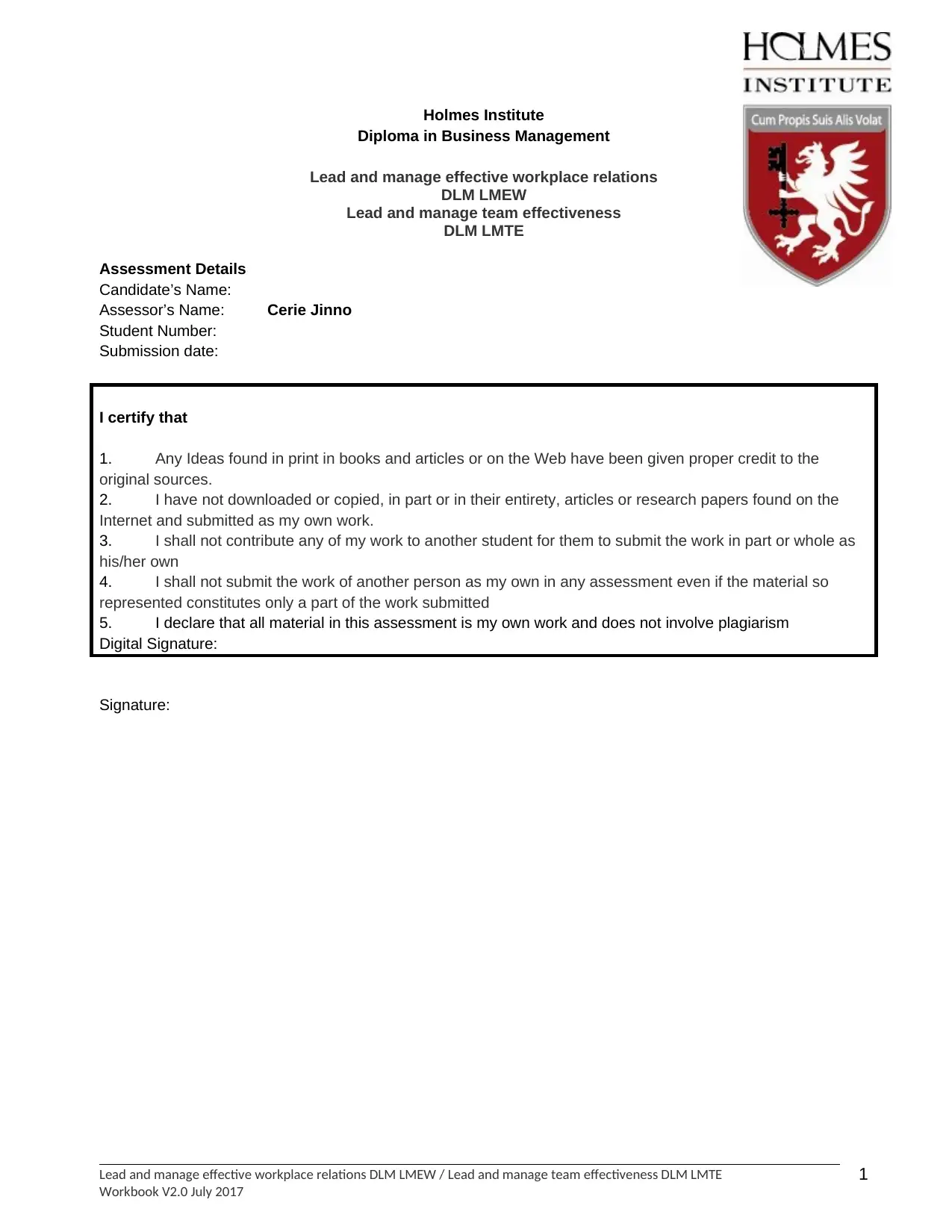
Holmes Institute
Diploma in Business Management
Lead and manage effective workplace relations
DLM LMEW
Lead and manage team effectiveness
DLM LMTE
Assessment Details
Candidate’s Name:
Assessor’s Name: Cerie Jinno
Student Number:
Submission date:
I certify that
1. Any Ideas found in print in books and articles or on the Web have been given proper credit to the
original sources.
2. I have not downloaded or copied, in part or in their entirety, articles or research papers found on the
Internet and submitted as my own work.
3. I shall not contribute any of my work to another student for them to submit the work in part or whole as
his/her own
4. I shall not submit the work of another person as my own in any assessment even if the material so
represented constitutes only a part of the work submitted
5. I declare that all material in this assessment is my own work and does not involve plagiarism
Digital Signature:
Signature:
Lead and manage effective workplace relations DLM LMEW / Lead and manage team effectiveness DLM LMTE
Workbook V2.0 July 2017
1
Diploma in Business Management
Lead and manage effective workplace relations
DLM LMEW
Lead and manage team effectiveness
DLM LMTE
Assessment Details
Candidate’s Name:
Assessor’s Name: Cerie Jinno
Student Number:
Submission date:
I certify that
1. Any Ideas found in print in books and articles or on the Web have been given proper credit to the
original sources.
2. I have not downloaded or copied, in part or in their entirety, articles or research papers found on the
Internet and submitted as my own work.
3. I shall not contribute any of my work to another student for them to submit the work in part or whole as
his/her own
4. I shall not submit the work of another person as my own in any assessment even if the material so
represented constitutes only a part of the work submitted
5. I declare that all material in this assessment is my own work and does not involve plagiarism
Digital Signature:
Signature:
Lead and manage effective workplace relations DLM LMEW / Lead and manage team effectiveness DLM LMTE
Workbook V2.0 July 2017
1
Secure Best Marks with AI Grader
Need help grading? Try our AI Grader for instant feedback on your assignments.
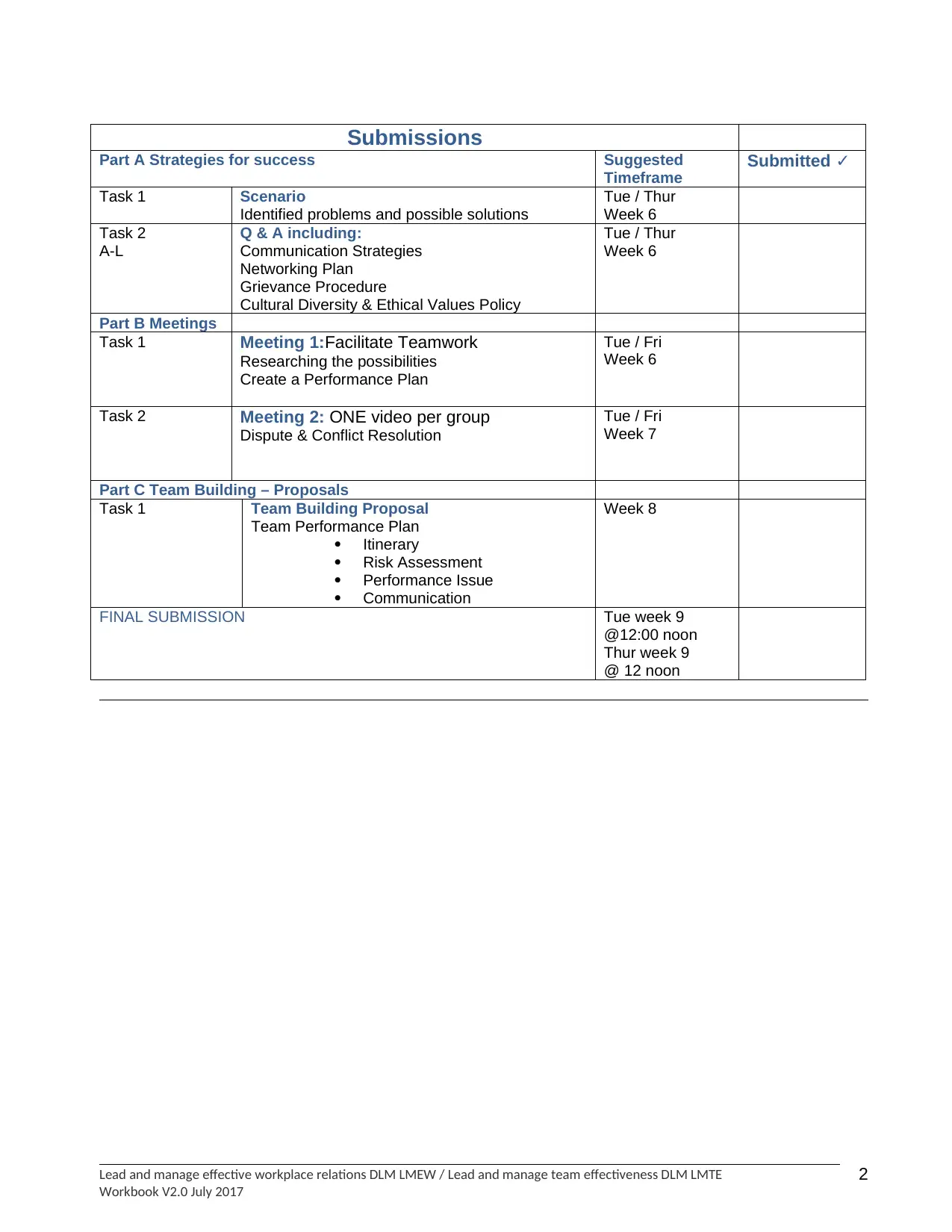
Submissions
Part A Strategies for success Suggested
Timeframe
Submitted ✓
Task 1 Scenario
Identified problems and possible solutions
Tue / Thur
Week 6
Task 2
A-L
Q & A including:
Communication Strategies
Networking Plan
Grievance Procedure
Cultural Diversity & Ethical Values Policy
Tue / Thur
Week 6
Part B Meetings
Task 1 Meeting 1:Facilitate Teamwork
Researching the possibilities
Create a Performance Plan
Tue / Fri
Week 6
Task 2 Meeting 2: ONE video per group
Dispute & Conflict Resolution
Tue / Fri
Week 7
Part C Team Building – Proposals
Task 1 Team Building Proposal
Team Performance Plan
Itinerary
Risk Assessment
Performance Issue
Communication
Week 8
FINAL SUBMISSION Tue week 9
@12:00 noon
Thur week 9
@ 12 noon
Lead and manage effective workplace relations DLM LMEW / Lead and manage team effectiveness DLM LMTE
Workbook V2.0 July 2017
2
Part A Strategies for success Suggested
Timeframe
Submitted ✓
Task 1 Scenario
Identified problems and possible solutions
Tue / Thur
Week 6
Task 2
A-L
Q & A including:
Communication Strategies
Networking Plan
Grievance Procedure
Cultural Diversity & Ethical Values Policy
Tue / Thur
Week 6
Part B Meetings
Task 1 Meeting 1:Facilitate Teamwork
Researching the possibilities
Create a Performance Plan
Tue / Fri
Week 6
Task 2 Meeting 2: ONE video per group
Dispute & Conflict Resolution
Tue / Fri
Week 7
Part C Team Building – Proposals
Task 1 Team Building Proposal
Team Performance Plan
Itinerary
Risk Assessment
Performance Issue
Communication
Week 8
FINAL SUBMISSION Tue week 9
@12:00 noon
Thur week 9
@ 12 noon
Lead and manage effective workplace relations DLM LMEW / Lead and manage team effectiveness DLM LMTE
Workbook V2.0 July 2017
2
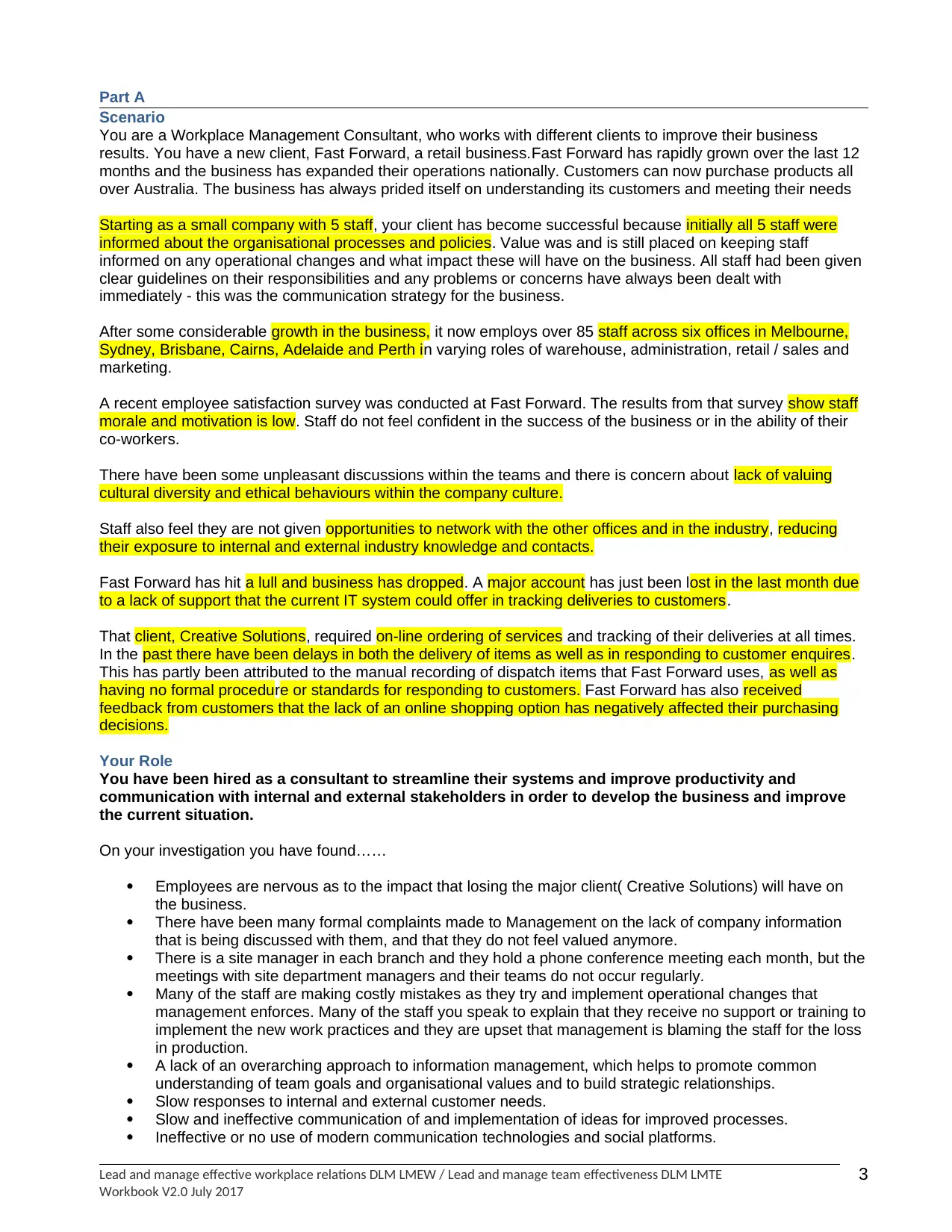
Part A
Scenario
You are a Workplace Management Consultant, who works with different clients to improve their business
results. You have a new client, Fast Forward, a retail business.Fast Forward has rapidly grown over the last 12
months and the business has expanded their operations nationally. Customers can now purchase products all
over Australia. The business has always prided itself on understanding its customers and meeting their needs
Starting as a small company with 5 staff, your client has become successful because initially all 5 staff were
informed about the organisational processes and policies. Value was and is still placed on keeping staff
informed on any operational changes and what impact these will have on the business. All staff had been given
clear guidelines on their responsibilities and any problems or concerns have always been dealt with
immediately - this was the communication strategy for the business.
After some considerable growth in the business, it now employs over 85 staff across six offices in Melbourne,
Sydney, Brisbane, Cairns, Adelaide and Perth in varying roles of warehouse, administration, retail / sales and
marketing.
A recent employee satisfaction survey was conducted at Fast Forward. The results from that survey show staff
morale and motivation is low. Staff do not feel confident in the success of the business or in the ability of their
co-workers.
There have been some unpleasant discussions within the teams and there is concern about lack of valuing
cultural diversity and ethical behaviours within the company culture.
Staff also feel they are not given opportunities to network with the other offices and in the industry, reducing
their exposure to internal and external industry knowledge and contacts.
Fast Forward has hit a lull and business has dropped. A major account has just been lost in the last month due
to a lack of support that the current IT system could offer in tracking deliveries to customers.
That client, Creative Solutions, required on-line ordering of services and tracking of their deliveries at all times.
In the past there have been delays in both the delivery of items as well as in responding to customer enquires.
This has partly been attributed to the manual recording of dispatch items that Fast Forward uses, as well as
having no formal procedure or standards for responding to customers. Fast Forward has also received
feedback from customers that the lack of an online shopping option has negatively affected their purchasing
decisions.
Your Role
You have been hired as a consultant to streamline their systems and improve productivity and
communication with internal and external stakeholders in order to develop the business and improve
the current situation.
On your investigation you have found……
Employees are nervous as to the impact that losing the major client( Creative Solutions) will have on
the business.
There have been many formal complaints made to Management on the lack of company information
that is being discussed with them, and that they do not feel valued anymore.
There is a site manager in each branch and they hold a phone conference meeting each month, but the
meetings with site department managers and their teams do not occur regularly.
Many of the staff are making costly mistakes as they try and implement operational changes that
management enforces. Many of the staff you speak to explain that they receive no support or training to
implement the new work practices and they are upset that management is blaming the staff for the loss
in production.
A lack of an overarching approach to information management, which helps to promote common
understanding of team goals and organisational values and to build strategic relationships.
Slow responses to internal and external customer needs.
Slow and ineffective communication of and implementation of ideas for improved processes.
Ineffective or no use of modern communication technologies and social platforms.
Lead and manage effective workplace relations DLM LMEW / Lead and manage team effectiveness DLM LMTE
Workbook V2.0 July 2017
3
Scenario
You are a Workplace Management Consultant, who works with different clients to improve their business
results. You have a new client, Fast Forward, a retail business.Fast Forward has rapidly grown over the last 12
months and the business has expanded their operations nationally. Customers can now purchase products all
over Australia. The business has always prided itself on understanding its customers and meeting their needs
Starting as a small company with 5 staff, your client has become successful because initially all 5 staff were
informed about the organisational processes and policies. Value was and is still placed on keeping staff
informed on any operational changes and what impact these will have on the business. All staff had been given
clear guidelines on their responsibilities and any problems or concerns have always been dealt with
immediately - this was the communication strategy for the business.
After some considerable growth in the business, it now employs over 85 staff across six offices in Melbourne,
Sydney, Brisbane, Cairns, Adelaide and Perth in varying roles of warehouse, administration, retail / sales and
marketing.
A recent employee satisfaction survey was conducted at Fast Forward. The results from that survey show staff
morale and motivation is low. Staff do not feel confident in the success of the business or in the ability of their
co-workers.
There have been some unpleasant discussions within the teams and there is concern about lack of valuing
cultural diversity and ethical behaviours within the company culture.
Staff also feel they are not given opportunities to network with the other offices and in the industry, reducing
their exposure to internal and external industry knowledge and contacts.
Fast Forward has hit a lull and business has dropped. A major account has just been lost in the last month due
to a lack of support that the current IT system could offer in tracking deliveries to customers.
That client, Creative Solutions, required on-line ordering of services and tracking of their deliveries at all times.
In the past there have been delays in both the delivery of items as well as in responding to customer enquires.
This has partly been attributed to the manual recording of dispatch items that Fast Forward uses, as well as
having no formal procedure or standards for responding to customers. Fast Forward has also received
feedback from customers that the lack of an online shopping option has negatively affected their purchasing
decisions.
Your Role
You have been hired as a consultant to streamline their systems and improve productivity and
communication with internal and external stakeholders in order to develop the business and improve
the current situation.
On your investigation you have found……
Employees are nervous as to the impact that losing the major client( Creative Solutions) will have on
the business.
There have been many formal complaints made to Management on the lack of company information
that is being discussed with them, and that they do not feel valued anymore.
There is a site manager in each branch and they hold a phone conference meeting each month, but the
meetings with site department managers and their teams do not occur regularly.
Many of the staff are making costly mistakes as they try and implement operational changes that
management enforces. Many of the staff you speak to explain that they receive no support or training to
implement the new work practices and they are upset that management is blaming the staff for the loss
in production.
A lack of an overarching approach to information management, which helps to promote common
understanding of team goals and organisational values and to build strategic relationships.
Slow responses to internal and external customer needs.
Slow and ineffective communication of and implementation of ideas for improved processes.
Ineffective or no use of modern communication technologies and social platforms.
Lead and manage effective workplace relations DLM LMEW / Lead and manage team effectiveness DLM LMTE
Workbook V2.0 July 2017
3
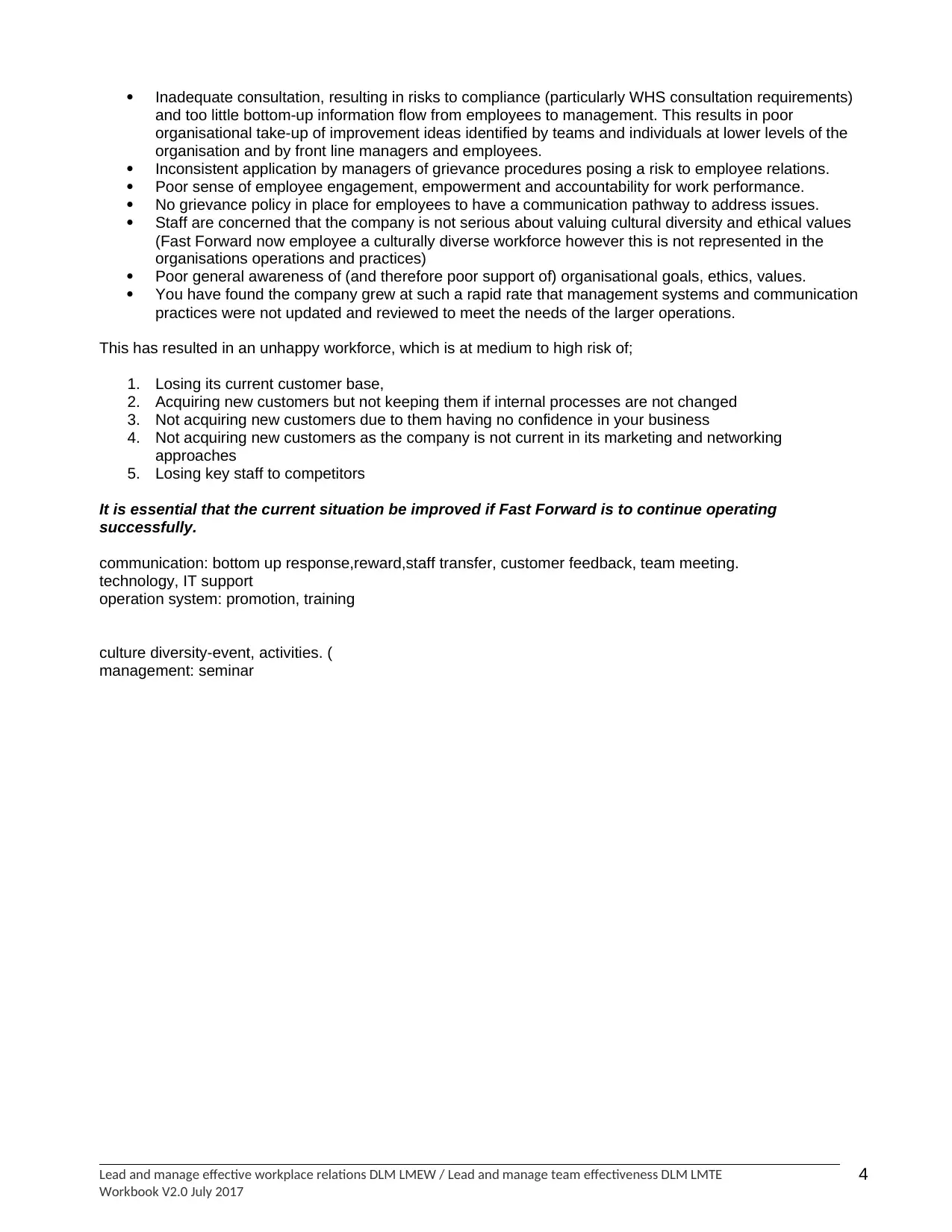
Inadequate consultation, resulting in risks to compliance (particularly WHS consultation requirements)
and too little bottom-up information flow from employees to management. This results in poor
organisational take-up of improvement ideas identified by teams and individuals at lower levels of the
organisation and by front line managers and employees.
Inconsistent application by managers of grievance procedures posing a risk to employee relations.
Poor sense of employee engagement, empowerment and accountability for work performance.
No grievance policy in place for employees to have a communication pathway to address issues.
Staff are concerned that the company is not serious about valuing cultural diversity and ethical values
(Fast Forward now employee a culturally diverse workforce however this is not represented in the
organisations operations and practices)
Poor general awareness of (and therefore poor support of) organisational goals, ethics, values.
You have found the company grew at such a rapid rate that management systems and communication
practices were not updated and reviewed to meet the needs of the larger operations.
This has resulted in an unhappy workforce, which is at medium to high risk of;
1. Losing its current customer base,
2. Acquiring new customers but not keeping them if internal processes are not changed
3. Not acquiring new customers due to them having no confidence in your business
4. Not acquiring new customers as the company is not current in its marketing and networking
approaches
5. Losing key staff to competitors
It is essential that the current situation be improved if Fast Forward is to continue operating
successfully.
communication: bottom up response,reward,staff transfer, customer feedback, team meeting.
technology, IT support
operation system: promotion, training
culture diversity-event, activities. (
management: seminar
Lead and manage effective workplace relations DLM LMEW / Lead and manage team effectiveness DLM LMTE
Workbook V2.0 July 2017
4
and too little bottom-up information flow from employees to management. This results in poor
organisational take-up of improvement ideas identified by teams and individuals at lower levels of the
organisation and by front line managers and employees.
Inconsistent application by managers of grievance procedures posing a risk to employee relations.
Poor sense of employee engagement, empowerment and accountability for work performance.
No grievance policy in place for employees to have a communication pathway to address issues.
Staff are concerned that the company is not serious about valuing cultural diversity and ethical values
(Fast Forward now employee a culturally diverse workforce however this is not represented in the
organisations operations and practices)
Poor general awareness of (and therefore poor support of) organisational goals, ethics, values.
You have found the company grew at such a rapid rate that management systems and communication
practices were not updated and reviewed to meet the needs of the larger operations.
This has resulted in an unhappy workforce, which is at medium to high risk of;
1. Losing its current customer base,
2. Acquiring new customers but not keeping them if internal processes are not changed
3. Not acquiring new customers due to them having no confidence in your business
4. Not acquiring new customers as the company is not current in its marketing and networking
approaches
5. Losing key staff to competitors
It is essential that the current situation be improved if Fast Forward is to continue operating
successfully.
communication: bottom up response,reward,staff transfer, customer feedback, team meeting.
technology, IT support
operation system: promotion, training
culture diversity-event, activities. (
management: seminar
Lead and manage effective workplace relations DLM LMEW / Lead and manage team effectiveness DLM LMTE
Workbook V2.0 July 2017
4
Secure Best Marks with AI Grader
Need help grading? Try our AI Grader for instant feedback on your assignments.
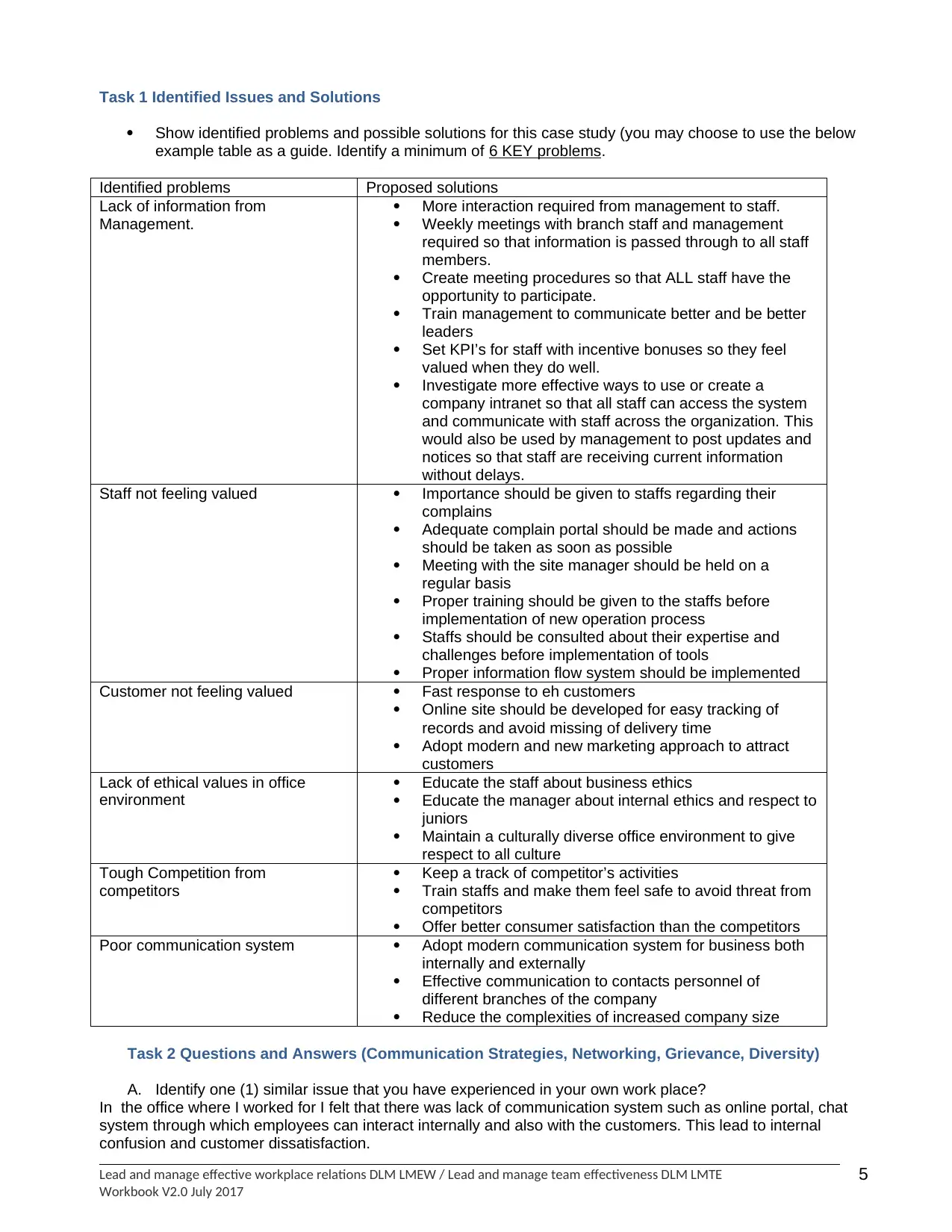
Task 1 Identified Issues and Solutions
Show identified problems and possible solutions for this case study (you may choose to use the below
example table as a guide. Identify a minimum of 6 KEY problems.
Identified problems Proposed solutions
Lack of information from
Management.
More interaction required from management to staff.
Weekly meetings with branch staff and management
required so that information is passed through to all staff
members.
Create meeting procedures so that ALL staff have the
opportunity to participate.
Train management to communicate better and be better
leaders
Set KPI’s for staff with incentive bonuses so they feel
valued when they do well.
Investigate more effective ways to use or create a
company intranet so that all staff can access the system
and communicate with staff across the organization. This
would also be used by management to post updates and
notices so that staff are receiving current information
without delays.
Staff not feeling valued Importance should be given to staffs regarding their
complains
Adequate complain portal should be made and actions
should be taken as soon as possible
Meeting with the site manager should be held on a
regular basis
Proper training should be given to the staffs before
implementation of new operation process
Staffs should be consulted about their expertise and
challenges before implementation of tools
Proper information flow system should be implemented
Customer not feeling valued Fast response to eh customers
Online site should be developed for easy tracking of
records and avoid missing of delivery time
Adopt modern and new marketing approach to attract
customers
Lack of ethical values in office
environment
Educate the staff about business ethics
Educate the manager about internal ethics and respect to
juniors
Maintain a culturally diverse office environment to give
respect to all culture
Tough Competition from
competitors
Keep a track of competitor’s activities
Train staffs and make them feel safe to avoid threat from
competitors
Offer better consumer satisfaction than the competitors
Poor communication system Adopt modern communication system for business both
internally and externally
Effective communication to contacts personnel of
different branches of the company
Reduce the complexities of increased company size
Task 2 Questions and Answers (Communication Strategies, Networking, Grievance, Diversity)
A. Identify one (1) similar issue that you have experienced in your own work place?
In the office where I worked for I felt that there was lack of communication system such as online portal, chat
system through which employees can interact internally and also with the customers. This lead to internal
confusion and customer dissatisfaction.
Lead and manage effective workplace relations DLM LMEW / Lead and manage team effectiveness DLM LMTE
Workbook V2.0 July 2017
5
Show identified problems and possible solutions for this case study (you may choose to use the below
example table as a guide. Identify a minimum of 6 KEY problems.
Identified problems Proposed solutions
Lack of information from
Management.
More interaction required from management to staff.
Weekly meetings with branch staff and management
required so that information is passed through to all staff
members.
Create meeting procedures so that ALL staff have the
opportunity to participate.
Train management to communicate better and be better
leaders
Set KPI’s for staff with incentive bonuses so they feel
valued when they do well.
Investigate more effective ways to use or create a
company intranet so that all staff can access the system
and communicate with staff across the organization. This
would also be used by management to post updates and
notices so that staff are receiving current information
without delays.
Staff not feeling valued Importance should be given to staffs regarding their
complains
Adequate complain portal should be made and actions
should be taken as soon as possible
Meeting with the site manager should be held on a
regular basis
Proper training should be given to the staffs before
implementation of new operation process
Staffs should be consulted about their expertise and
challenges before implementation of tools
Proper information flow system should be implemented
Customer not feeling valued Fast response to eh customers
Online site should be developed for easy tracking of
records and avoid missing of delivery time
Adopt modern and new marketing approach to attract
customers
Lack of ethical values in office
environment
Educate the staff about business ethics
Educate the manager about internal ethics and respect to
juniors
Maintain a culturally diverse office environment to give
respect to all culture
Tough Competition from
competitors
Keep a track of competitor’s activities
Train staffs and make them feel safe to avoid threat from
competitors
Offer better consumer satisfaction than the competitors
Poor communication system Adopt modern communication system for business both
internally and externally
Effective communication to contacts personnel of
different branches of the company
Reduce the complexities of increased company size
Task 2 Questions and Answers (Communication Strategies, Networking, Grievance, Diversity)
A. Identify one (1) similar issue that you have experienced in your own work place?
In the office where I worked for I felt that there was lack of communication system such as online portal, chat
system through which employees can interact internally and also with the customers. This lead to internal
confusion and customer dissatisfaction.
Lead and manage effective workplace relations DLM LMEW / Lead and manage team effectiveness DLM LMTE
Workbook V2.0 July 2017
5
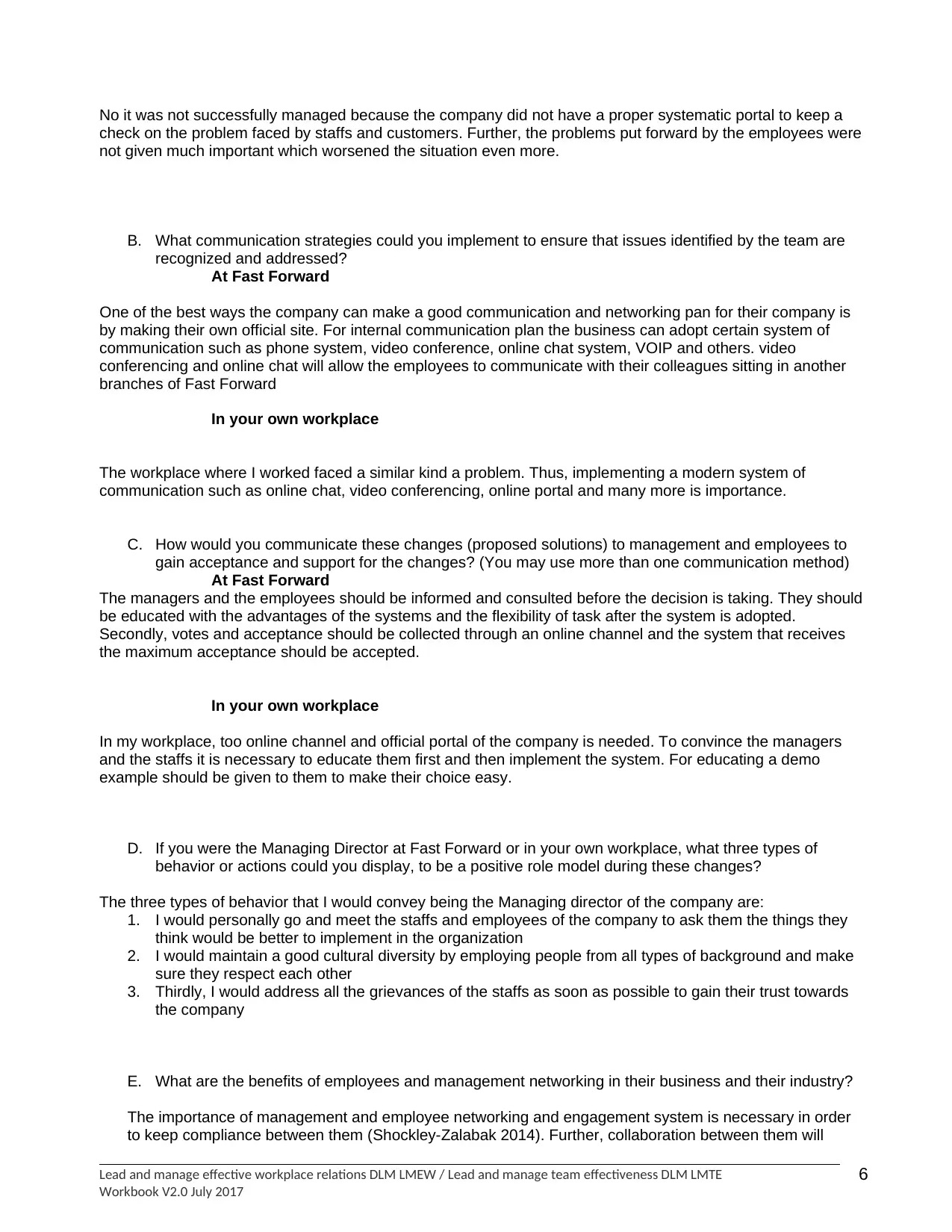
No it was not successfully managed because the company did not have a proper systematic portal to keep a
check on the problem faced by staffs and customers. Further, the problems put forward by the employees were
not given much important which worsened the situation even more.
B. What communication strategies could you implement to ensure that issues identified by the team are
recognized and addressed?
At Fast Forward
One of the best ways the company can make a good communication and networking pan for their company is
by making their own official site. For internal communication plan the business can adopt certain system of
communication such as phone system, video conference, online chat system, VOIP and others. video
conferencing and online chat will allow the employees to communicate with their colleagues sitting in another
branches of Fast Forward
In your own workplace
The workplace where I worked faced a similar kind a problem. Thus, implementing a modern system of
communication such as online chat, video conferencing, online portal and many more is importance.
C. How would you communicate these changes (proposed solutions) to management and employees to
gain acceptance and support for the changes? (You may use more than one communication method)
At Fast Forward
The managers and the employees should be informed and consulted before the decision is taking. They should
be educated with the advantages of the systems and the flexibility of task after the system is adopted.
Secondly, votes and acceptance should be collected through an online channel and the system that receives
the maximum acceptance should be accepted.
In your own workplace
In my workplace, too online channel and official portal of the company is needed. To convince the managers
and the staffs it is necessary to educate them first and then implement the system. For educating a demo
example should be given to them to make their choice easy.
D. If you were the Managing Director at Fast Forward or in your own workplace, what three types of
behavior or actions could you display, to be a positive role model during these changes?
The three types of behavior that I would convey being the Managing director of the company are:
1. I would personally go and meet the staffs and employees of the company to ask them the things they
think would be better to implement in the organization
2. I would maintain a good cultural diversity by employing people from all types of background and make
sure they respect each other
3. Thirdly, I would address all the grievances of the staffs as soon as possible to gain their trust towards
the company
E. What are the benefits of employees and management networking in their business and their industry?
The importance of management and employee networking and engagement system is necessary in order
to keep compliance between them (Shockley-Zalabak 2014). Further, collaboration between them will
Lead and manage effective workplace relations DLM LMEW / Lead and manage team effectiveness DLM LMTE
Workbook V2.0 July 2017
6
check on the problem faced by staffs and customers. Further, the problems put forward by the employees were
not given much important which worsened the situation even more.
B. What communication strategies could you implement to ensure that issues identified by the team are
recognized and addressed?
At Fast Forward
One of the best ways the company can make a good communication and networking pan for their company is
by making their own official site. For internal communication plan the business can adopt certain system of
communication such as phone system, video conference, online chat system, VOIP and others. video
conferencing and online chat will allow the employees to communicate with their colleagues sitting in another
branches of Fast Forward
In your own workplace
The workplace where I worked faced a similar kind a problem. Thus, implementing a modern system of
communication such as online chat, video conferencing, online portal and many more is importance.
C. How would you communicate these changes (proposed solutions) to management and employees to
gain acceptance and support for the changes? (You may use more than one communication method)
At Fast Forward
The managers and the employees should be informed and consulted before the decision is taking. They should
be educated with the advantages of the systems and the flexibility of task after the system is adopted.
Secondly, votes and acceptance should be collected through an online channel and the system that receives
the maximum acceptance should be accepted.
In your own workplace
In my workplace, too online channel and official portal of the company is needed. To convince the managers
and the staffs it is necessary to educate them first and then implement the system. For educating a demo
example should be given to them to make their choice easy.
D. If you were the Managing Director at Fast Forward or in your own workplace, what three types of
behavior or actions could you display, to be a positive role model during these changes?
The three types of behavior that I would convey being the Managing director of the company are:
1. I would personally go and meet the staffs and employees of the company to ask them the things they
think would be better to implement in the organization
2. I would maintain a good cultural diversity by employing people from all types of background and make
sure they respect each other
3. Thirdly, I would address all the grievances of the staffs as soon as possible to gain their trust towards
the company
E. What are the benefits of employees and management networking in their business and their industry?
The importance of management and employee networking and engagement system is necessary in order
to keep compliance between them (Shockley-Zalabak 2014). Further, collaboration between them will
Lead and manage effective workplace relations DLM LMEW / Lead and manage team effectiveness DLM LMTE
Workbook V2.0 July 2017
6
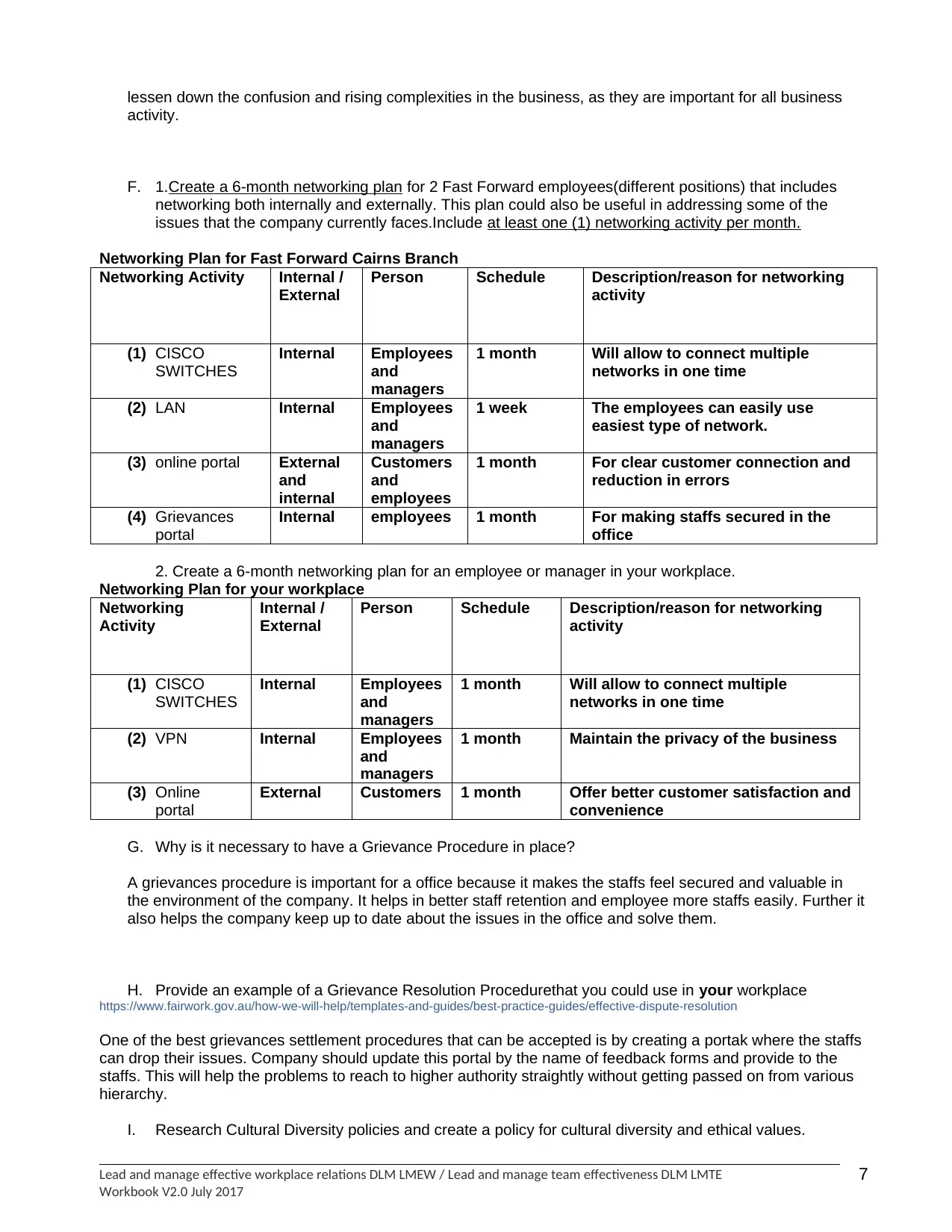
lessen down the confusion and rising complexities in the business, as they are important for all business
activity.
F. 1.Create a 6-month networking plan for 2 Fast Forward employees(different positions) that includes
networking both internally and externally. This plan could also be useful in addressing some of the
issues that the company currently faces.Include at least one (1) networking activity per month.
Networking Plan for Fast Forward Cairns Branch
Networking Activity Internal /
External
Person Schedule Description/reason for networking
activity
(1) CISCO
SWITCHES
Internal Employees
and
managers
1 month Will allow to connect multiple
networks in one time
(2) LAN Internal Employees
and
managers
1 week The employees can easily use
easiest type of network.
(3) online portal External
and
internal
Customers
and
employees
1 month For clear customer connection and
reduction in errors
(4) Grievances
portal
Internal employees 1 month For making staffs secured in the
office
2. Create a 6-month networking plan for an employee or manager in your workplace.
Networking Plan for your workplace
Networking
Activity
Internal /
External
Person Schedule Description/reason for networking
activity
(1) CISCO
SWITCHES
Internal Employees
and
managers
1 month Will allow to connect multiple
networks in one time
(2) VPN Internal Employees
and
managers
1 month Maintain the privacy of the business
(3) Online
portal
External Customers 1 month Offer better customer satisfaction and
convenience
G. Why is it necessary to have a Grievance Procedure in place?
A grievances procedure is important for a office because it makes the staffs feel secured and valuable in
the environment of the company. It helps in better staff retention and employee more staffs easily. Further it
also helps the company keep up to date about the issues in the office and solve them.
H. Provide an example of a Grievance Resolution Procedurethat you could use in your workplace
https://www.fairwork.gov.au/how-we-will-help/templates-and-guides/best-practice-guides/effective-dispute-resolution
One of the best grievances settlement procedures that can be accepted is by creating a portak where the staffs
can drop their issues. Company should update this portal by the name of feedback forms and provide to the
staffs. This will help the problems to reach to higher authority straightly without getting passed on from various
hierarchy.
I. Research Cultural Diversity policies and create a policy for cultural diversity and ethical values.
Lead and manage effective workplace relations DLM LMEW / Lead and manage team effectiveness DLM LMTE
Workbook V2.0 July 2017
7
activity.
F. 1.Create a 6-month networking plan for 2 Fast Forward employees(different positions) that includes
networking both internally and externally. This plan could also be useful in addressing some of the
issues that the company currently faces.Include at least one (1) networking activity per month.
Networking Plan for Fast Forward Cairns Branch
Networking Activity Internal /
External
Person Schedule Description/reason for networking
activity
(1) CISCO
SWITCHES
Internal Employees
and
managers
1 month Will allow to connect multiple
networks in one time
(2) LAN Internal Employees
and
managers
1 week The employees can easily use
easiest type of network.
(3) online portal External
and
internal
Customers
and
employees
1 month For clear customer connection and
reduction in errors
(4) Grievances
portal
Internal employees 1 month For making staffs secured in the
office
2. Create a 6-month networking plan for an employee or manager in your workplace.
Networking Plan for your workplace
Networking
Activity
Internal /
External
Person Schedule Description/reason for networking
activity
(1) CISCO
SWITCHES
Internal Employees
and
managers
1 month Will allow to connect multiple
networks in one time
(2) VPN Internal Employees
and
managers
1 month Maintain the privacy of the business
(3) Online
portal
External Customers 1 month Offer better customer satisfaction and
convenience
G. Why is it necessary to have a Grievance Procedure in place?
A grievances procedure is important for a office because it makes the staffs feel secured and valuable in
the environment of the company. It helps in better staff retention and employee more staffs easily. Further it
also helps the company keep up to date about the issues in the office and solve them.
H. Provide an example of a Grievance Resolution Procedurethat you could use in your workplace
https://www.fairwork.gov.au/how-we-will-help/templates-and-guides/best-practice-guides/effective-dispute-resolution
One of the best grievances settlement procedures that can be accepted is by creating a portak where the staffs
can drop their issues. Company should update this portal by the name of feedback forms and provide to the
staffs. This will help the problems to reach to higher authority straightly without getting passed on from various
hierarchy.
I. Research Cultural Diversity policies and create a policy for cultural diversity and ethical values.
Lead and manage effective workplace relations DLM LMEW / Lead and manage team effectiveness DLM LMTE
Workbook V2.0 July 2017
7
Paraphrase This Document
Need a fresh take? Get an instant paraphrase of this document with our AI Paraphraser
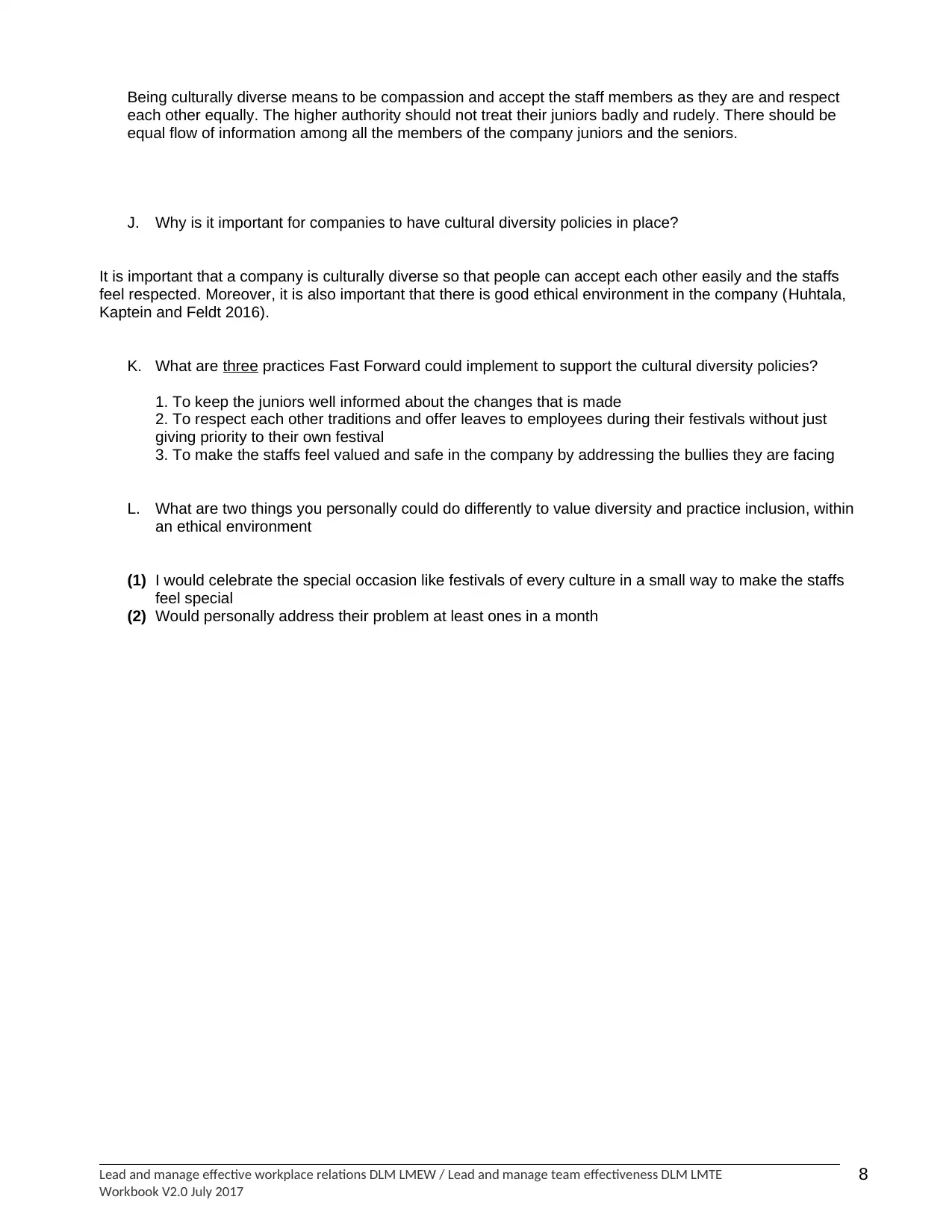
Being culturally diverse means to be compassion and accept the staff members as they are and respect
each other equally. The higher authority should not treat their juniors badly and rudely. There should be
equal flow of information among all the members of the company juniors and the seniors.
J. Why is it important for companies to have cultural diversity policies in place?
It is important that a company is culturally diverse so that people can accept each other easily and the staffs
feel respected. Moreover, it is also important that there is good ethical environment in the company (Huhtala,
Kaptein and Feldt 2016).
K. What are three practices Fast Forward could implement to support the cultural diversity policies?
1. To keep the juniors well informed about the changes that is made
2. To respect each other traditions and offer leaves to employees during their festivals without just
giving priority to their own festival
3. To make the staffs feel valued and safe in the company by addressing the bullies they are facing
L. What are two things you personally could do differently to value diversity and practice inclusion, within
an ethical environment
(1) I would celebrate the special occasion like festivals of every culture in a small way to make the staffs
feel special
(2) Would personally address their problem at least ones in a month
Lead and manage effective workplace relations DLM LMEW / Lead and manage team effectiveness DLM LMTE
Workbook V2.0 July 2017
8
each other equally. The higher authority should not treat their juniors badly and rudely. There should be
equal flow of information among all the members of the company juniors and the seniors.
J. Why is it important for companies to have cultural diversity policies in place?
It is important that a company is culturally diverse so that people can accept each other easily and the staffs
feel respected. Moreover, it is also important that there is good ethical environment in the company (Huhtala,
Kaptein and Feldt 2016).
K. What are three practices Fast Forward could implement to support the cultural diversity policies?
1. To keep the juniors well informed about the changes that is made
2. To respect each other traditions and offer leaves to employees during their festivals without just
giving priority to their own festival
3. To make the staffs feel valued and safe in the company by addressing the bullies they are facing
L. What are two things you personally could do differently to value diversity and practice inclusion, within
an ethical environment
(1) I would celebrate the special occasion like festivals of every culture in a small way to make the staffs
feel special
(2) Would personally address their problem at least ones in a month
Lead and manage effective workplace relations DLM LMEW / Lead and manage team effectiveness DLM LMTE
Workbook V2.0 July 2017
8
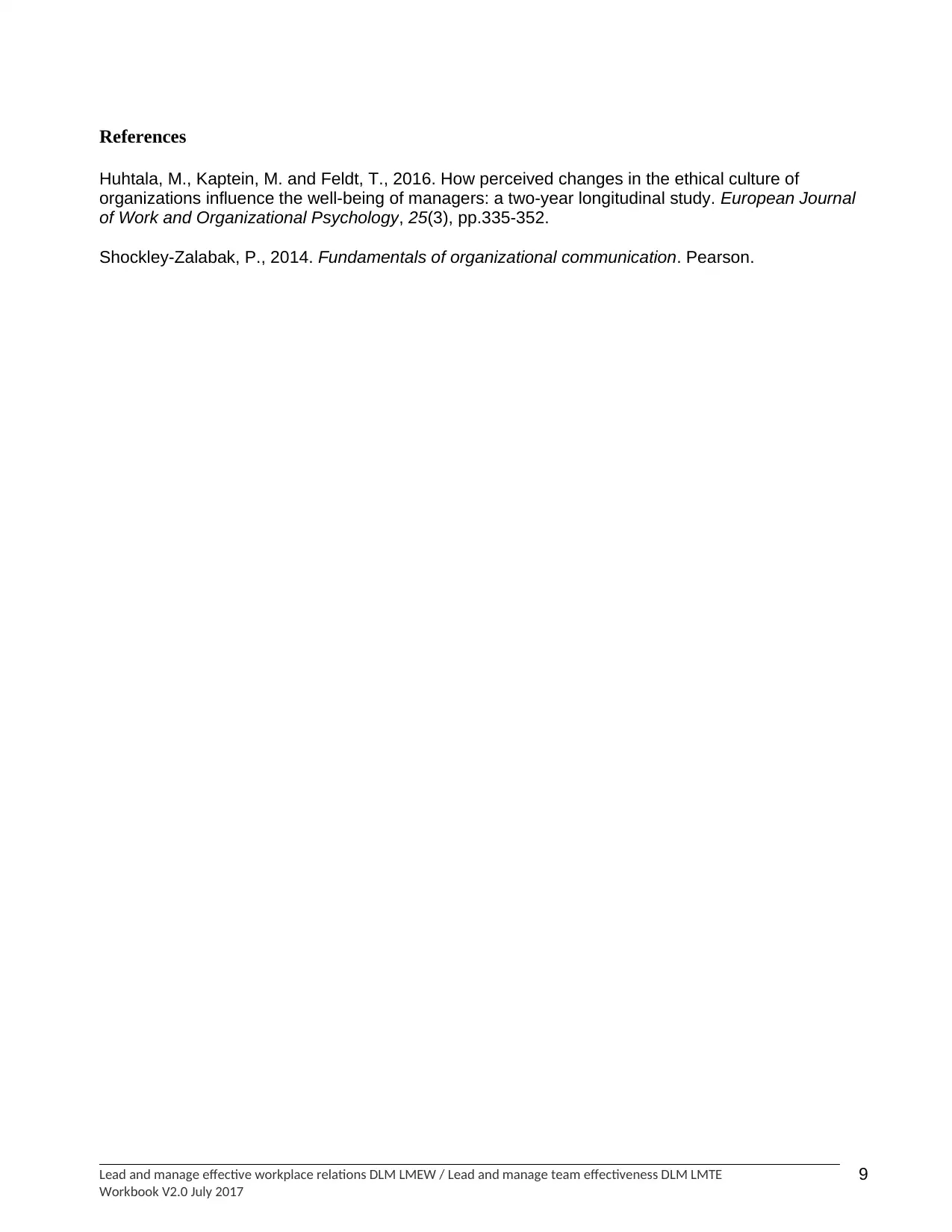
References
Huhtala, M., Kaptein, M. and Feldt, T., 2016. How perceived changes in the ethical culture of
organizations influence the well-being of managers: a two-year longitudinal study. European Journal
of Work and Organizational Psychology, 25(3), pp.335-352.
Shockley-Zalabak, P., 2014. Fundamentals of organizational communication. Pearson.
Lead and manage effective workplace relations DLM LMEW / Lead and manage team effectiveness DLM LMTE
Workbook V2.0 July 2017
9
Huhtala, M., Kaptein, M. and Feldt, T., 2016. How perceived changes in the ethical culture of
organizations influence the well-being of managers: a two-year longitudinal study. European Journal
of Work and Organizational Psychology, 25(3), pp.335-352.
Shockley-Zalabak, P., 2014. Fundamentals of organizational communication. Pearson.
Lead and manage effective workplace relations DLM LMEW / Lead and manage team effectiveness DLM LMTE
Workbook V2.0 July 2017
9
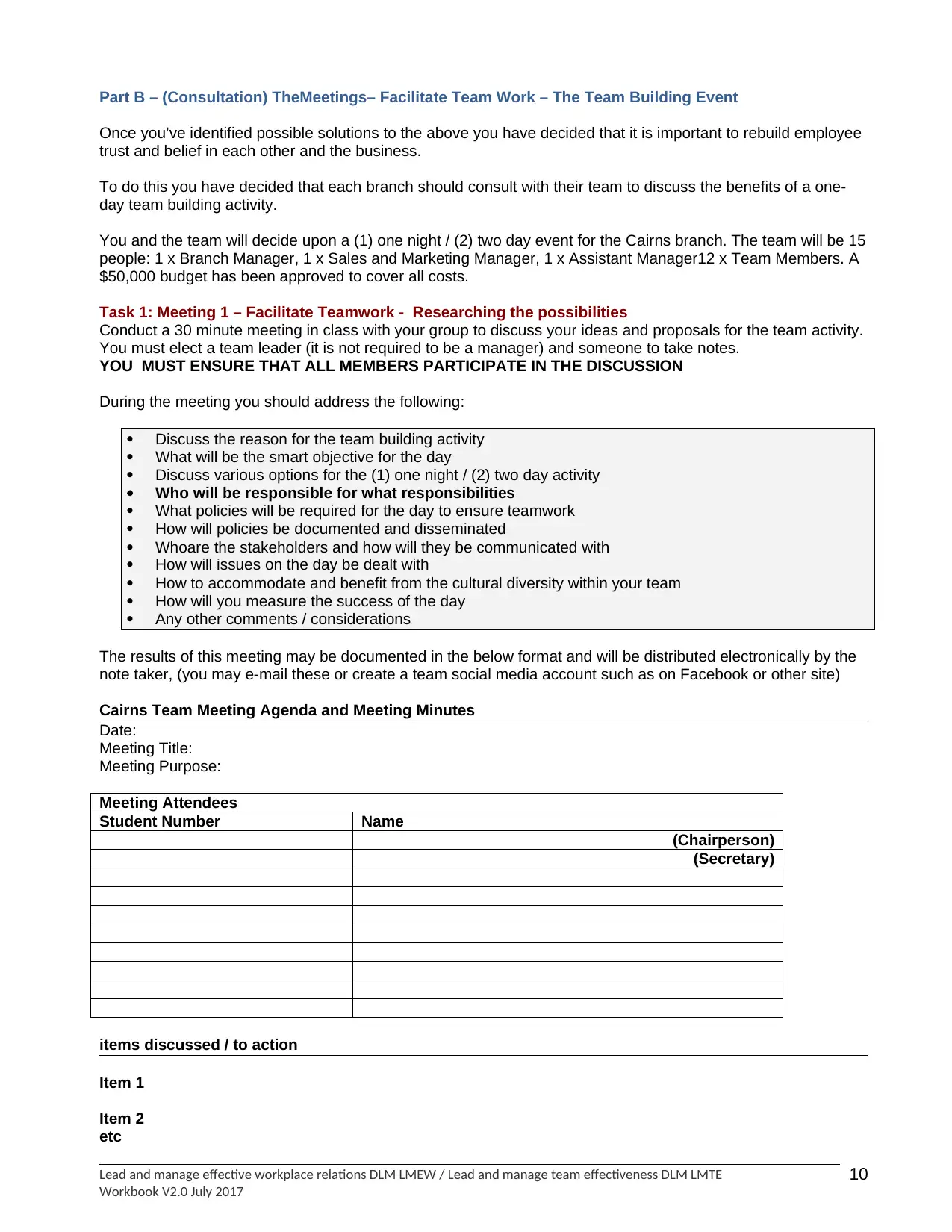
Part B – (Consultation) TheMeetings– Facilitate Team Work – The Team Building Event
Once you’ve identified possible solutions to the above you have decided that it is important to rebuild employee
trust and belief in each other and the business.
To do this you have decided that each branch should consult with their team to discuss the benefits of a one-
day team building activity.
You and the team will decide upon a (1) one night / (2) two day event for the Cairns branch. The team will be 15
people: 1 x Branch Manager, 1 x Sales and Marketing Manager, 1 x Assistant Manager12 x Team Members. A
$50,000 budget has been approved to cover all costs.
Task 1: Meeting 1 – Facilitate Teamwork - Researching the possibilities
Conduct a 30 minute meeting in class with your group to discuss your ideas and proposals for the team activity.
You must elect a team leader (it is not required to be a manager) and someone to take notes.
YOU MUST ENSURE THAT ALL MEMBERS PARTICIPATE IN THE DISCUSSION
During the meeting you should address the following:
Discuss the reason for the team building activity
What will be the smart objective for the day
Discuss various options for the (1) one night / (2) two day activity
Who will be responsible for what responsibilities
What policies will be required for the day to ensure teamwork
How will policies be documented and disseminated
Whoare the stakeholders and how will they be communicated with
How will issues on the day be dealt with
How to accommodate and benefit from the cultural diversity within your team
How will you measure the success of the day
Any other comments / considerations
The results of this meeting may be documented in the below format and will be distributed electronically by the
note taker, (you may e-mail these or create a team social media account such as on Facebook or other site)
Cairns Team Meeting Agenda and Meeting Minutes
Date:
Meeting Title:
Meeting Purpose:
Meeting Attendees
Student Number Name
(Chairperson)
(Secretary)
items discussed / to action
Item 1
Item 2
etc
Lead and manage effective workplace relations DLM LMEW / Lead and manage team effectiveness DLM LMTE
Workbook V2.0 July 2017
10
Once you’ve identified possible solutions to the above you have decided that it is important to rebuild employee
trust and belief in each other and the business.
To do this you have decided that each branch should consult with their team to discuss the benefits of a one-
day team building activity.
You and the team will decide upon a (1) one night / (2) two day event for the Cairns branch. The team will be 15
people: 1 x Branch Manager, 1 x Sales and Marketing Manager, 1 x Assistant Manager12 x Team Members. A
$50,000 budget has been approved to cover all costs.
Task 1: Meeting 1 – Facilitate Teamwork - Researching the possibilities
Conduct a 30 minute meeting in class with your group to discuss your ideas and proposals for the team activity.
You must elect a team leader (it is not required to be a manager) and someone to take notes.
YOU MUST ENSURE THAT ALL MEMBERS PARTICIPATE IN THE DISCUSSION
During the meeting you should address the following:
Discuss the reason for the team building activity
What will be the smart objective for the day
Discuss various options for the (1) one night / (2) two day activity
Who will be responsible for what responsibilities
What policies will be required for the day to ensure teamwork
How will policies be documented and disseminated
Whoare the stakeholders and how will they be communicated with
How will issues on the day be dealt with
How to accommodate and benefit from the cultural diversity within your team
How will you measure the success of the day
Any other comments / considerations
The results of this meeting may be documented in the below format and will be distributed electronically by the
note taker, (you may e-mail these or create a team social media account such as on Facebook or other site)
Cairns Team Meeting Agenda and Meeting Minutes
Date:
Meeting Title:
Meeting Purpose:
Meeting Attendees
Student Number Name
(Chairperson)
(Secretary)
items discussed / to action
Item 1
Item 2
etc
Lead and manage effective workplace relations DLM LMEW / Lead and manage team effectiveness DLM LMTE
Workbook V2.0 July 2017
10
Secure Best Marks with AI Grader
Need help grading? Try our AI Grader for instant feedback on your assignments.
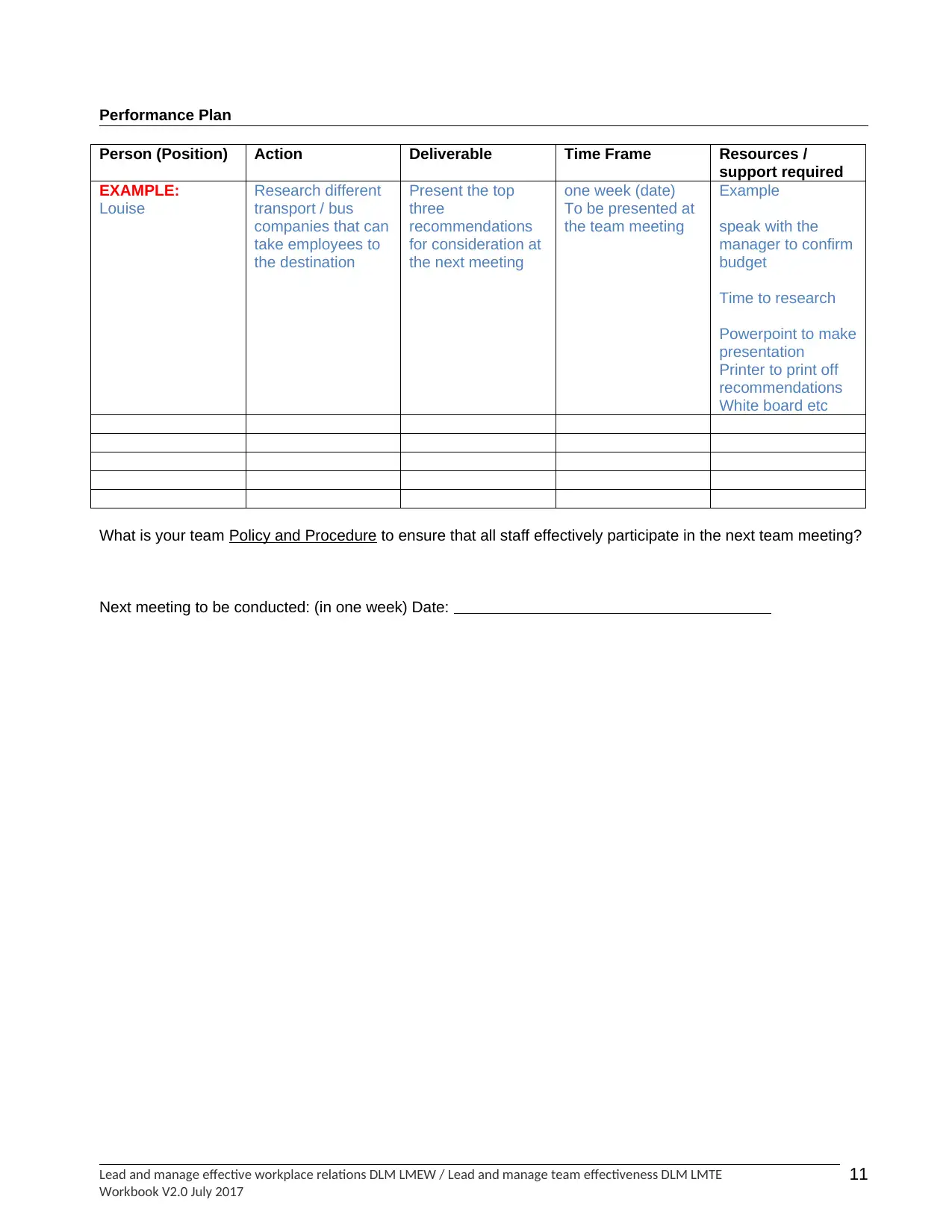
Performance Plan
Person (Position) Action Deliverable Time Frame Resources /
support required
EXAMPLE:
Louise
Research different
transport / bus
companies that can
take employees to
the destination
Present the top
three
recommendations
for consideration at
the next meeting
one week (date)
To be presented at
the team meeting
Example
speak with the
manager to confirm
budget
Time to research
Powerpoint to make
presentation
Printer to print off
recommendations
White board etc
What is your team Policy and Procedure to ensure that all staff effectively participate in the next team meeting?
Next meeting to be conducted: (in one week) Date:
Lead and manage effective workplace relations DLM LMEW / Lead and manage team effectiveness DLM LMTE
Workbook V2.0 July 2017
11
Person (Position) Action Deliverable Time Frame Resources /
support required
EXAMPLE:
Louise
Research different
transport / bus
companies that can
take employees to
the destination
Present the top
three
recommendations
for consideration at
the next meeting
one week (date)
To be presented at
the team meeting
Example
speak with the
manager to confirm
budget
Time to research
Powerpoint to make
presentation
Printer to print off
recommendations
White board etc
What is your team Policy and Procedure to ensure that all staff effectively participate in the next team meeting?
Next meeting to be conducted: (in one week) Date:
Lead and manage effective workplace relations DLM LMEW / Lead and manage team effectiveness DLM LMTE
Workbook V2.0 July 2017
11
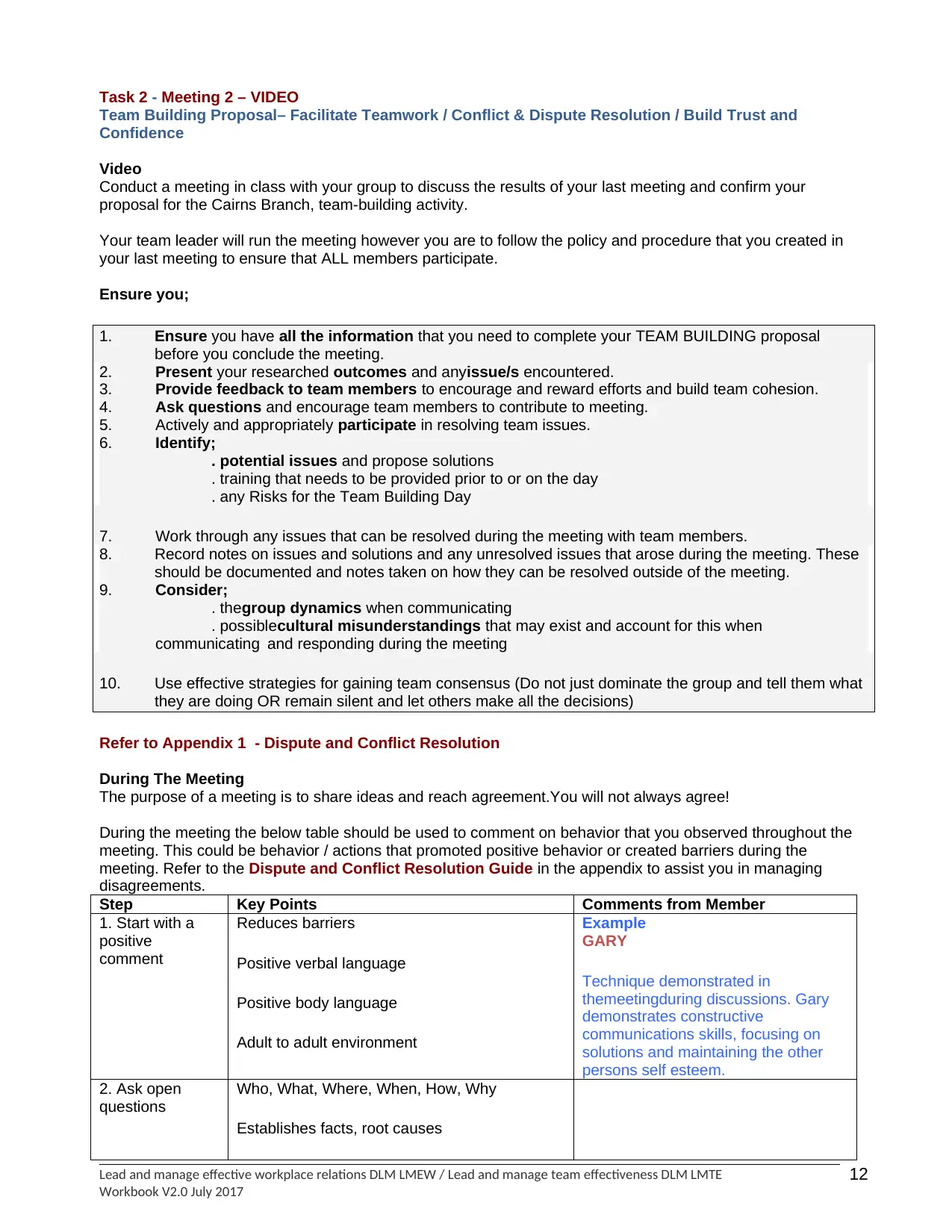
Task 2 - Meeting 2 – VIDEO
Team Building Proposal– Facilitate Teamwork / Conflict & Dispute Resolution / Build Trust and
Confidence
Video
Conduct a meeting in class with your group to discuss the results of your last meeting and confirm your
proposal for the Cairns Branch, team-building activity.
Your team leader will run the meeting however you are to follow the policy and procedure that you created in
your last meeting to ensure that ALL members participate.
Ensure you;
1. Ensure you have all the information that you need to complete your TEAM BUILDING proposal
before you conclude the meeting.
2. Present your researched outcomes and anyissue/s encountered.
3. Provide feedback to team members to encourage and reward efforts and build team cohesion.
4. Ask questions and encourage team members to contribute to meeting.
5. Actively and appropriately participate in resolving team issues.
6. Identify;
. potential issues and propose solutions
. training that needs to be provided prior to or on the day
. any Risks for the Team Building Day
7. Work through any issues that can be resolved during the meeting with team members.
8. Record notes on issues and solutions and any unresolved issues that arose during the meeting. These
should be documented and notes taken on how they can be resolved outside of the meeting.
9. Consider;
. thegroup dynamics when communicating
. possiblecultural misunderstandings that may exist and account for this when
communicating and responding during the meeting
10. Use effective strategies for gaining team consensus (Do not just dominate the group and tell them what
they are doing OR remain silent and let others make all the decisions)
Refer to Appendix 1 - Dispute and Conflict Resolution
During The Meeting
The purpose of a meeting is to share ideas and reach agreement.You will not always agree!
During the meeting the below table should be used to comment on behavior that you observed throughout the
meeting. This could be behavior / actions that promoted positive behavior or created barriers during the
meeting. Refer to the Dispute and Conflict Resolution Guide in the appendix to assist you in managing
disagreements.
Step Key Points Comments from Member
1. Start with a
positive
comment
Reduces barriers
Positive verbal language
Positive body language
Adult to adult environment
Example
GARY
Technique demonstrated in
themeetingduring discussions. Gary
demonstrates constructive
communications skills, focusing on
solutions and maintaining the other
persons self esteem.
2. Ask open
questions
Who, What, Where, When, How, Why
Establishes facts, root causes
Lead and manage effective workplace relations DLM LMEW / Lead and manage team effectiveness DLM LMTE
Workbook V2.0 July 2017
12
Team Building Proposal– Facilitate Teamwork / Conflict & Dispute Resolution / Build Trust and
Confidence
Video
Conduct a meeting in class with your group to discuss the results of your last meeting and confirm your
proposal for the Cairns Branch, team-building activity.
Your team leader will run the meeting however you are to follow the policy and procedure that you created in
your last meeting to ensure that ALL members participate.
Ensure you;
1. Ensure you have all the information that you need to complete your TEAM BUILDING proposal
before you conclude the meeting.
2. Present your researched outcomes and anyissue/s encountered.
3. Provide feedback to team members to encourage and reward efforts and build team cohesion.
4. Ask questions and encourage team members to contribute to meeting.
5. Actively and appropriately participate in resolving team issues.
6. Identify;
. potential issues and propose solutions
. training that needs to be provided prior to or on the day
. any Risks for the Team Building Day
7. Work through any issues that can be resolved during the meeting with team members.
8. Record notes on issues and solutions and any unresolved issues that arose during the meeting. These
should be documented and notes taken on how they can be resolved outside of the meeting.
9. Consider;
. thegroup dynamics when communicating
. possiblecultural misunderstandings that may exist and account for this when
communicating and responding during the meeting
10. Use effective strategies for gaining team consensus (Do not just dominate the group and tell them what
they are doing OR remain silent and let others make all the decisions)
Refer to Appendix 1 - Dispute and Conflict Resolution
During The Meeting
The purpose of a meeting is to share ideas and reach agreement.You will not always agree!
During the meeting the below table should be used to comment on behavior that you observed throughout the
meeting. This could be behavior / actions that promoted positive behavior or created barriers during the
meeting. Refer to the Dispute and Conflict Resolution Guide in the appendix to assist you in managing
disagreements.
Step Key Points Comments from Member
1. Start with a
positive
comment
Reduces barriers
Positive verbal language
Positive body language
Adult to adult environment
Example
GARY
Technique demonstrated in
themeetingduring discussions. Gary
demonstrates constructive
communications skills, focusing on
solutions and maintaining the other
persons self esteem.
2. Ask open
questions
Who, What, Where, When, How, Why
Establishes facts, root causes
Lead and manage effective workplace relations DLM LMEW / Lead and manage team effectiveness DLM LMTE
Workbook V2.0 July 2017
12
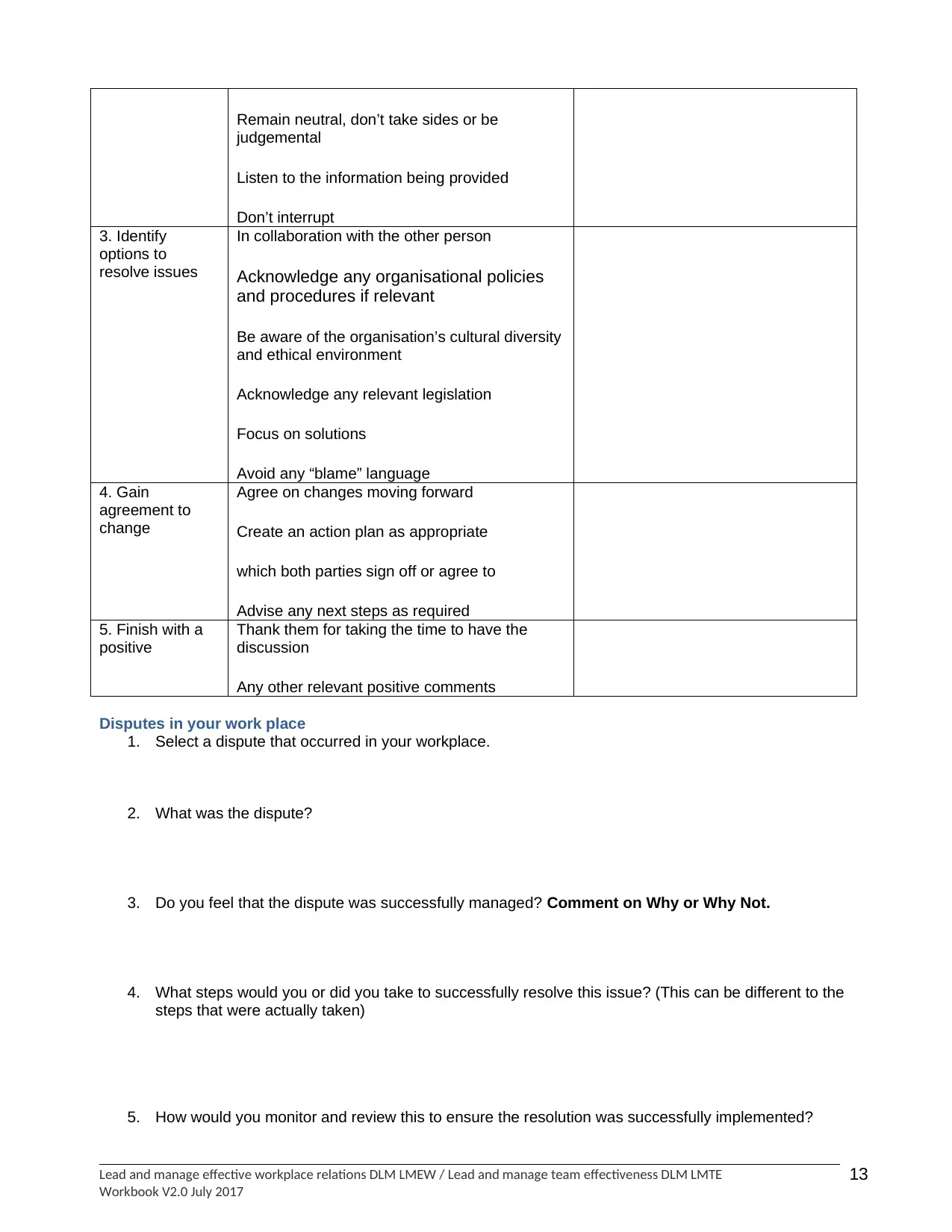
Remain neutral, don’t take sides or be
judgemental
Listen to the information being provided
Don’t interrupt
3. Identify
options to
resolve issues
In collaboration with the other person
Acknowledge any organisational policies
and procedures if relevant
Be aware of the organisation’s cultural diversity
and ethical environment
Acknowledge any relevant legislation
Focus on solutions
Avoid any “blame” language
4. Gain
agreement to
change
Agree on changes moving forward
Create an action plan as appropriate
which both parties sign off or agree to
Advise any next steps as required
5. Finish with a
positive
Thank them for taking the time to have the
discussion
Any other relevant positive comments
Disputes in your work place
1. Select a dispute that occurred in your workplace.
2. What was the dispute?
3. Do you feel that the dispute was successfully managed? Comment on Why or Why Not.
4. What steps would you or did you take to successfully resolve this issue? (This can be different to the
steps that were actually taken)
5. How would you monitor and review this to ensure the resolution was successfully implemented?
Lead and manage effective workplace relations DLM LMEW / Lead and manage team effectiveness DLM LMTE
Workbook V2.0 July 2017
13
judgemental
Listen to the information being provided
Don’t interrupt
3. Identify
options to
resolve issues
In collaboration with the other person
Acknowledge any organisational policies
and procedures if relevant
Be aware of the organisation’s cultural diversity
and ethical environment
Acknowledge any relevant legislation
Focus on solutions
Avoid any “blame” language
4. Gain
agreement to
change
Agree on changes moving forward
Create an action plan as appropriate
which both parties sign off or agree to
Advise any next steps as required
5. Finish with a
positive
Thank them for taking the time to have the
discussion
Any other relevant positive comments
Disputes in your work place
1. Select a dispute that occurred in your workplace.
2. What was the dispute?
3. Do you feel that the dispute was successfully managed? Comment on Why or Why Not.
4. What steps would you or did you take to successfully resolve this issue? (This can be different to the
steps that were actually taken)
5. How would you monitor and review this to ensure the resolution was successfully implemented?
Lead and manage effective workplace relations DLM LMEW / Lead and manage team effectiveness DLM LMTE
Workbook V2.0 July 2017
13
Paraphrase This Document
Need a fresh take? Get an instant paraphrase of this document with our AI Paraphraser
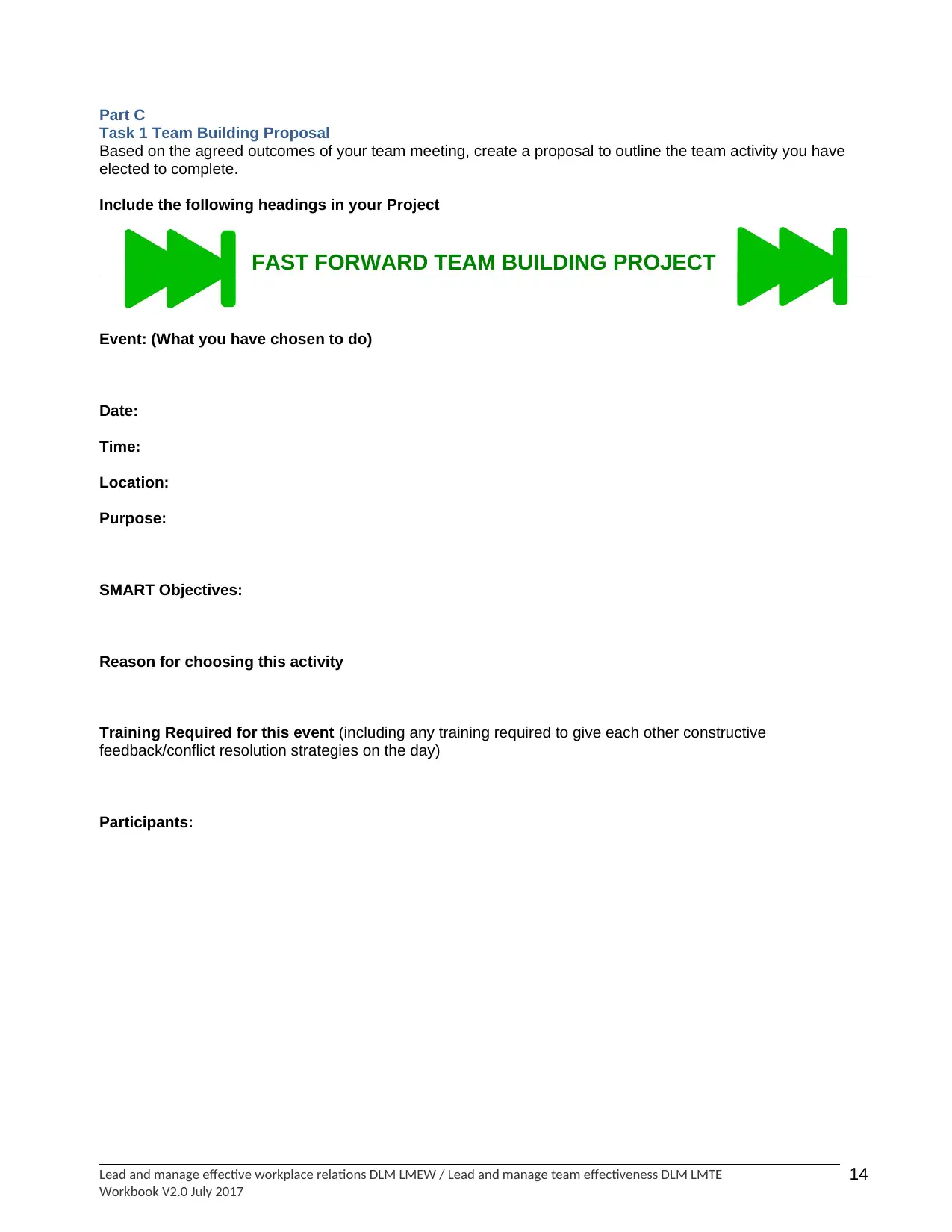
Part C
Task 1 Team Building Proposal
Based on the agreed outcomes of your team meeting, create a proposal to outline the team activity you have
elected to complete.
Include the following headings in your Project
FAST FORWARD TEAM BUILDING PROJECT
Event: (What you have chosen to do)
Date:
Time:
Location:
Purpose:
SMART Objectives:
Reason for choosing this activity
Training Required for this event (including any training required to give each other constructive
feedback/conflict resolution strategies on the day)
Participants:
Lead and manage effective workplace relations DLM LMEW / Lead and manage team effectiveness DLM LMTE
Workbook V2.0 July 2017
14
Task 1 Team Building Proposal
Based on the agreed outcomes of your team meeting, create a proposal to outline the team activity you have
elected to complete.
Include the following headings in your Project
FAST FORWARD TEAM BUILDING PROJECT
Event: (What you have chosen to do)
Date:
Time:
Location:
Purpose:
SMART Objectives:
Reason for choosing this activity
Training Required for this event (including any training required to give each other constructive
feedback/conflict resolution strategies on the day)
Participants:
Lead and manage effective workplace relations DLM LMEW / Lead and manage team effectiveness DLM LMTE
Workbook V2.0 July 2017
14
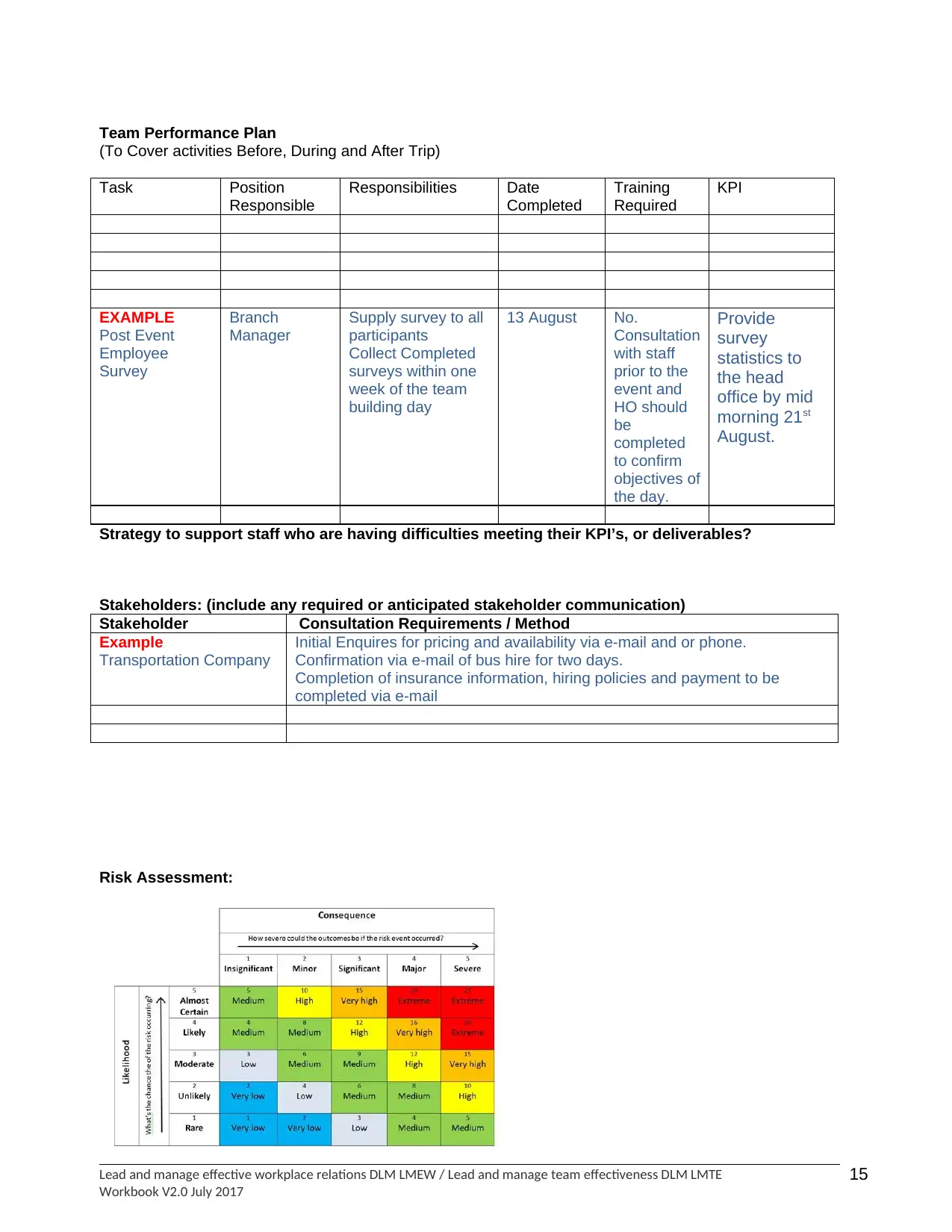
Team Performance Plan
(To Cover activities Before, During and After Trip)
Task Position
Responsible
Responsibilities Date
Completed
Training
Required
KPI
EXAMPLE
Post Event
Employee
Survey
Branch
Manager
Supply survey to all
participants
Collect Completed
surveys within one
week of the team
building day
13 August No.
Consultation
with staff
prior to the
event and
HO should
be
completed
to confirm
objectives of
the day.
Provide
survey
statistics to
the head
office by mid
morning 21st
August.
Strategy to support staff who are having difficulties meeting their KPI’s, or deliverables?
Stakeholders: (include any required or anticipated stakeholder communication)
Stakeholder Consultation Requirements / Method
Example
Transportation Company
Initial Enquires for pricing and availability via e-mail and or phone.
Confirmation via e-mail of bus hire for two days.
Completion of insurance information, hiring policies and payment to be
completed via e-mail
Risk Assessment:
Lead and manage effective workplace relations DLM LMEW / Lead and manage team effectiveness DLM LMTE
Workbook V2.0 July 2017
15
(To Cover activities Before, During and After Trip)
Task Position
Responsible
Responsibilities Date
Completed
Training
Required
KPI
EXAMPLE
Post Event
Employee
Survey
Branch
Manager
Supply survey to all
participants
Collect Completed
surveys within one
week of the team
building day
13 August No.
Consultation
with staff
prior to the
event and
HO should
be
completed
to confirm
objectives of
the day.
Provide
survey
statistics to
the head
office by mid
morning 21st
August.
Strategy to support staff who are having difficulties meeting their KPI’s, or deliverables?
Stakeholders: (include any required or anticipated stakeholder communication)
Stakeholder Consultation Requirements / Method
Example
Transportation Company
Initial Enquires for pricing and availability via e-mail and or phone.
Confirmation via e-mail of bus hire for two days.
Completion of insurance information, hiring policies and payment to be
completed via e-mail
Risk Assessment:
Lead and manage effective workplace relations DLM LMEW / Lead and manage team effectiveness DLM LMTE
Workbook V2.0 July 2017
15
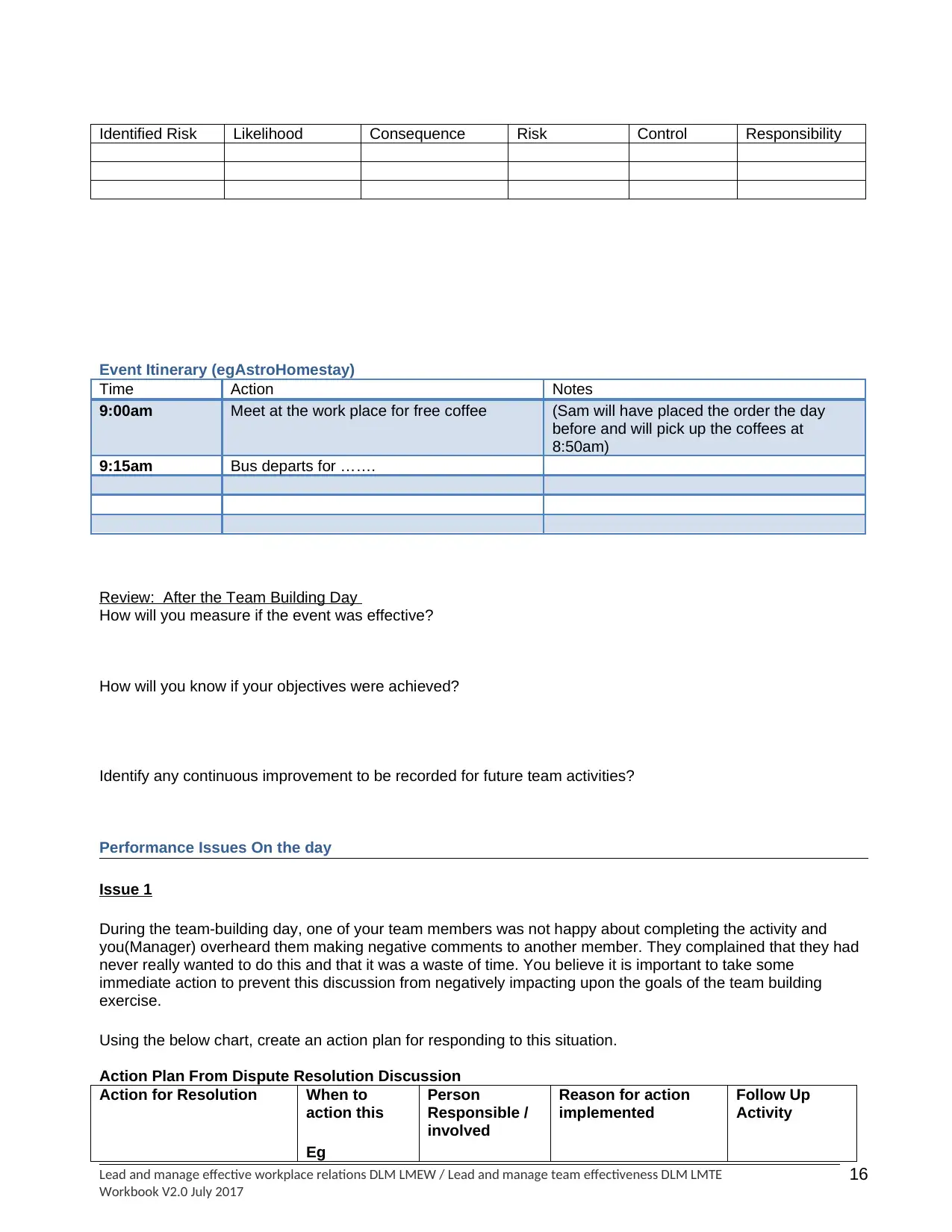
Identified Risk Likelihood Consequence Risk Control Responsibility
Event Itinerary (egAstroHomestay)
Time Action Notes
9:00am Meet at the work place for free coffee (Sam will have placed the order the day
before and will pick up the coffees at
8:50am)
9:15am Bus departs for …….
Review: After the Team Building Day
How will you measure if the event was effective?
How will you know if your objectives were achieved?
Identify any continuous improvement to be recorded for future team activities?
Performance Issues On the day
Issue 1
During the team-building day, one of your team members was not happy about completing the activity and
you(Manager) overheard them making negative comments to another member. They complained that they had
never really wanted to do this and that it was a waste of time. You believe it is important to take some
immediate action to prevent this discussion from negatively impacting upon the goals of the team building
exercise.
Using the below chart, create an action plan for responding to this situation.
Action Plan From Dispute Resolution Discussion
Action for Resolution When to
action this
Eg
Person
Responsible /
involved
Reason for action
implemented
Follow Up
Activity
Lead and manage effective workplace relations DLM LMEW / Lead and manage team effectiveness DLM LMTE
Workbook V2.0 July 2017
16
Event Itinerary (egAstroHomestay)
Time Action Notes
9:00am Meet at the work place for free coffee (Sam will have placed the order the day
before and will pick up the coffees at
8:50am)
9:15am Bus departs for …….
Review: After the Team Building Day
How will you measure if the event was effective?
How will you know if your objectives were achieved?
Identify any continuous improvement to be recorded for future team activities?
Performance Issues On the day
Issue 1
During the team-building day, one of your team members was not happy about completing the activity and
you(Manager) overheard them making negative comments to another member. They complained that they had
never really wanted to do this and that it was a waste of time. You believe it is important to take some
immediate action to prevent this discussion from negatively impacting upon the goals of the team building
exercise.
Using the below chart, create an action plan for responding to this situation.
Action Plan From Dispute Resolution Discussion
Action for Resolution When to
action this
Eg
Person
Responsible /
involved
Reason for action
implemented
Follow Up
Activity
Lead and manage effective workplace relations DLM LMEW / Lead and manage team effectiveness DLM LMTE
Workbook V2.0 July 2017
16
Secure Best Marks with AI Grader
Need help grading? Try our AI Grader for instant feedback on your assignments.
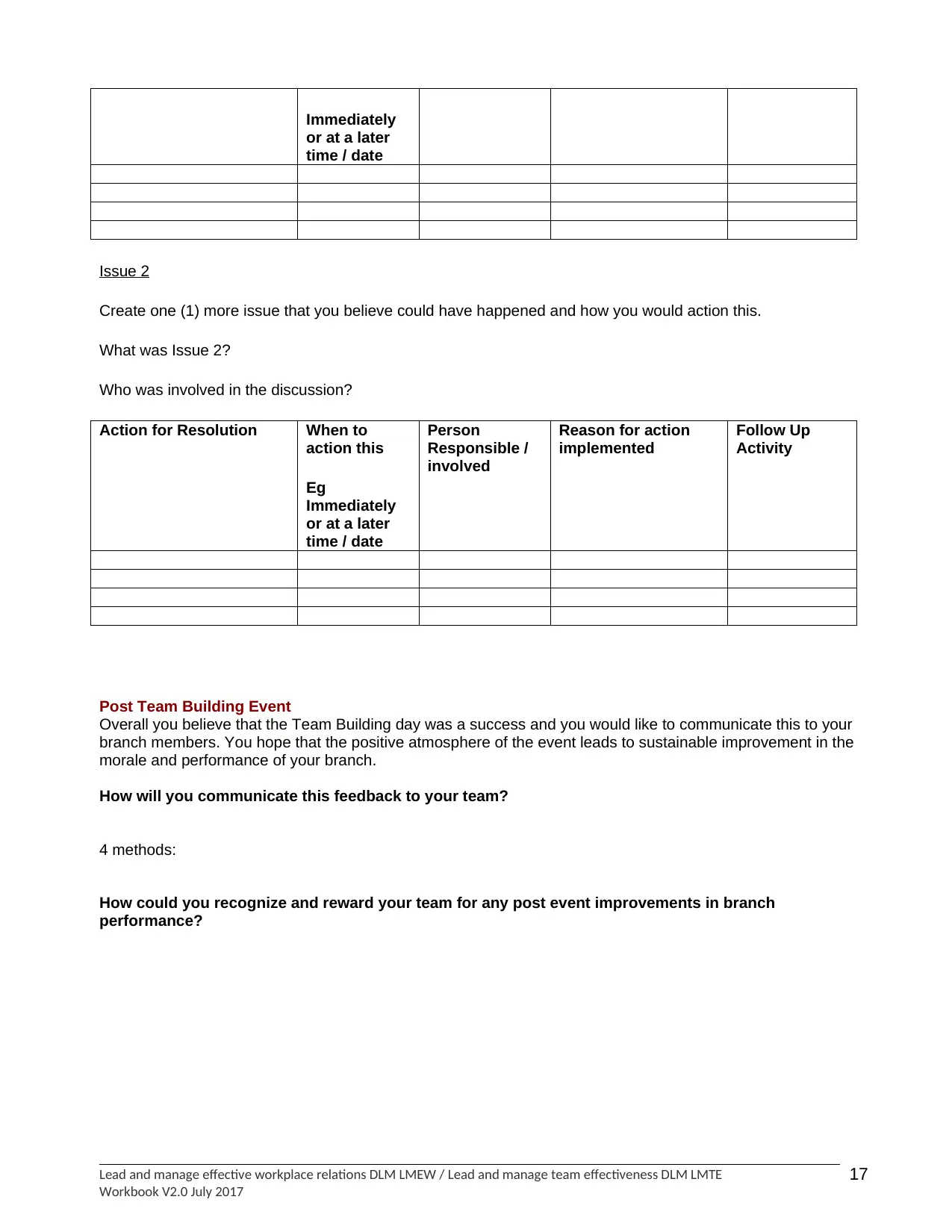
Immediately
or at a later
time / date
Issue 2
Create one (1) more issue that you believe could have happened and how you would action this.
What was Issue 2?
Who was involved in the discussion?
Action for Resolution When to
action this
Eg
Immediately
or at a later
time / date
Person
Responsible /
involved
Reason for action
implemented
Follow Up
Activity
Post Team Building Event
Overall you believe that the Team Building day was a success and you would like to communicate this to your
branch members. You hope that the positive atmosphere of the event leads to sustainable improvement in the
morale and performance of your branch.
How will you communicate this feedback to your team?
4 methods:
How could you recognize and reward your team for any post event improvements in branch
performance?
Lead and manage effective workplace relations DLM LMEW / Lead and manage team effectiveness DLM LMTE
Workbook V2.0 July 2017
17
or at a later
time / date
Issue 2
Create one (1) more issue that you believe could have happened and how you would action this.
What was Issue 2?
Who was involved in the discussion?
Action for Resolution When to
action this
Eg
Immediately
or at a later
time / date
Person
Responsible /
involved
Reason for action
implemented
Follow Up
Activity
Post Team Building Event
Overall you believe that the Team Building day was a success and you would like to communicate this to your
branch members. You hope that the positive atmosphere of the event leads to sustainable improvement in the
morale and performance of your branch.
How will you communicate this feedback to your team?
4 methods:
How could you recognize and reward your team for any post event improvements in branch
performance?
Lead and manage effective workplace relations DLM LMEW / Lead and manage team effectiveness DLM LMTE
Workbook V2.0 July 2017
17
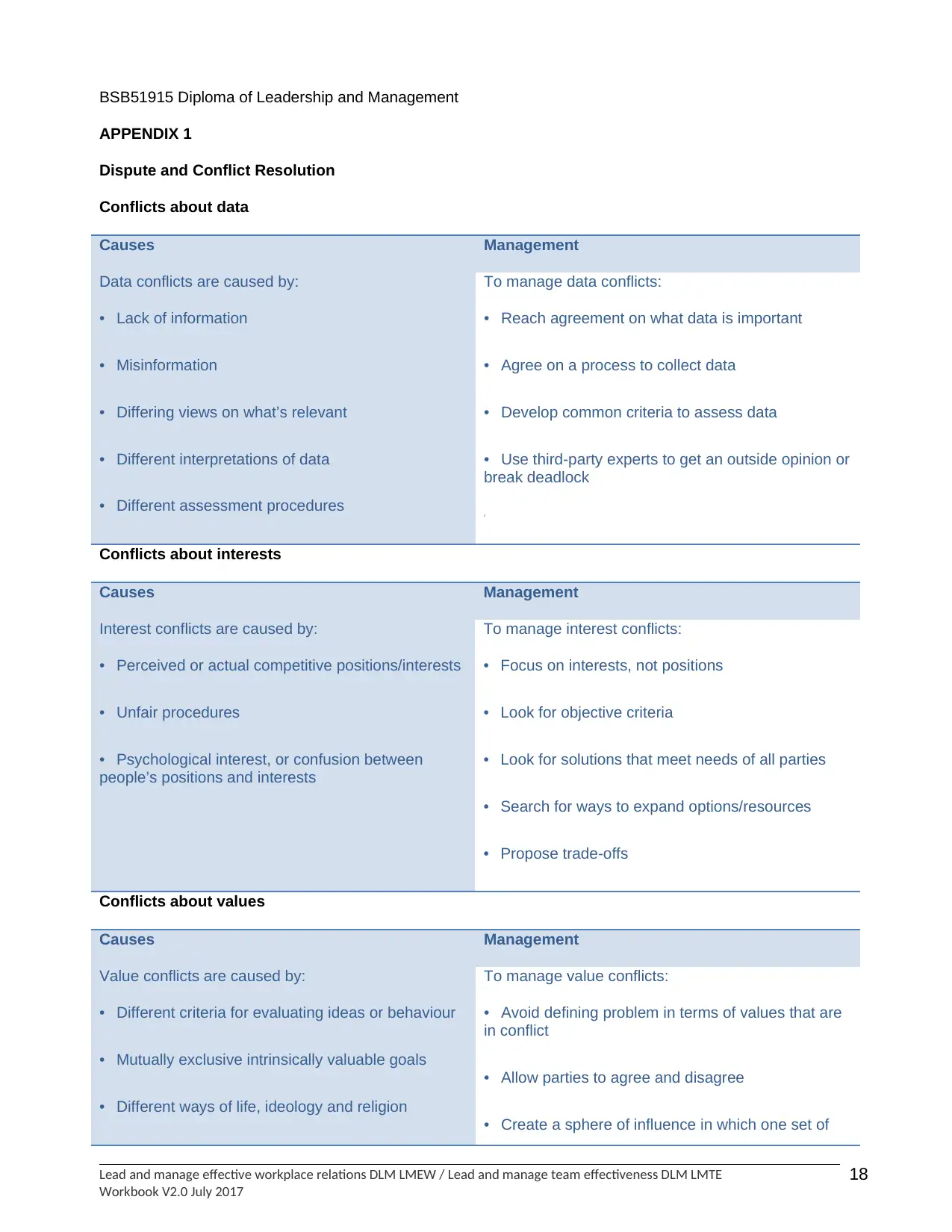
BSB51915 Diploma of Leadership and Management
APPENDIX 1
Dispute and Conflict Resolution
Conflicts about data
Causes Management
Data conflicts are caused by:
• Lack of information
• Misinformation
• Differing views on what’s relevant
• Different interpretations of data
• Different assessment procedures
To manage data conflicts:
• Reach agreement on what data is important
• Agree on a process to collect data
• Develop common criteria to assess data
• Use third-party experts to get an outside opinion or
break deadlock
Conflicts about interests
Causes Management
Interest conflicts are caused by:
• Perceived or actual competitive positions/interests
• Unfair procedures
• Psychological interest, or confusion between
people’s positions and interests
To manage interest conflicts:
• Focus on interests, not positions
• Look for objective criteria
• Look for solutions that meet needs of all parties
• Search for ways to expand options/resources
• Propose trade-offs
Conflicts about values
Causes Management
Value conflicts are caused by:
• Different criteria for evaluating ideas or behaviour
• Mutually exclusive intrinsically valuable goals
• Different ways of life, ideology and religion
To manage value conflicts:
• Avoid defining problem in terms of values that are
in conflict
• Allow parties to agree and disagree
• Create a sphere of influence in which one set of
Lead and manage effective workplace relations DLM LMEW / Lead and manage team effectiveness DLM LMTE
Workbook V2.0 July 2017
18
APPENDIX 1
Dispute and Conflict Resolution
Conflicts about data
Causes Management
Data conflicts are caused by:
• Lack of information
• Misinformation
• Differing views on what’s relevant
• Different interpretations of data
• Different assessment procedures
To manage data conflicts:
• Reach agreement on what data is important
• Agree on a process to collect data
• Develop common criteria to assess data
• Use third-party experts to get an outside opinion or
break deadlock
Conflicts about interests
Causes Management
Interest conflicts are caused by:
• Perceived or actual competitive positions/interests
• Unfair procedures
• Psychological interest, or confusion between
people’s positions and interests
To manage interest conflicts:
• Focus on interests, not positions
• Look for objective criteria
• Look for solutions that meet needs of all parties
• Search for ways to expand options/resources
• Propose trade-offs
Conflicts about values
Causes Management
Value conflicts are caused by:
• Different criteria for evaluating ideas or behaviour
• Mutually exclusive intrinsically valuable goals
• Different ways of life, ideology and religion
To manage value conflicts:
• Avoid defining problem in terms of values that are
in conflict
• Allow parties to agree and disagree
• Create a sphere of influence in which one set of
Lead and manage effective workplace relations DLM LMEW / Lead and manage team effectiveness DLM LMTE
Workbook V2.0 July 2017
18
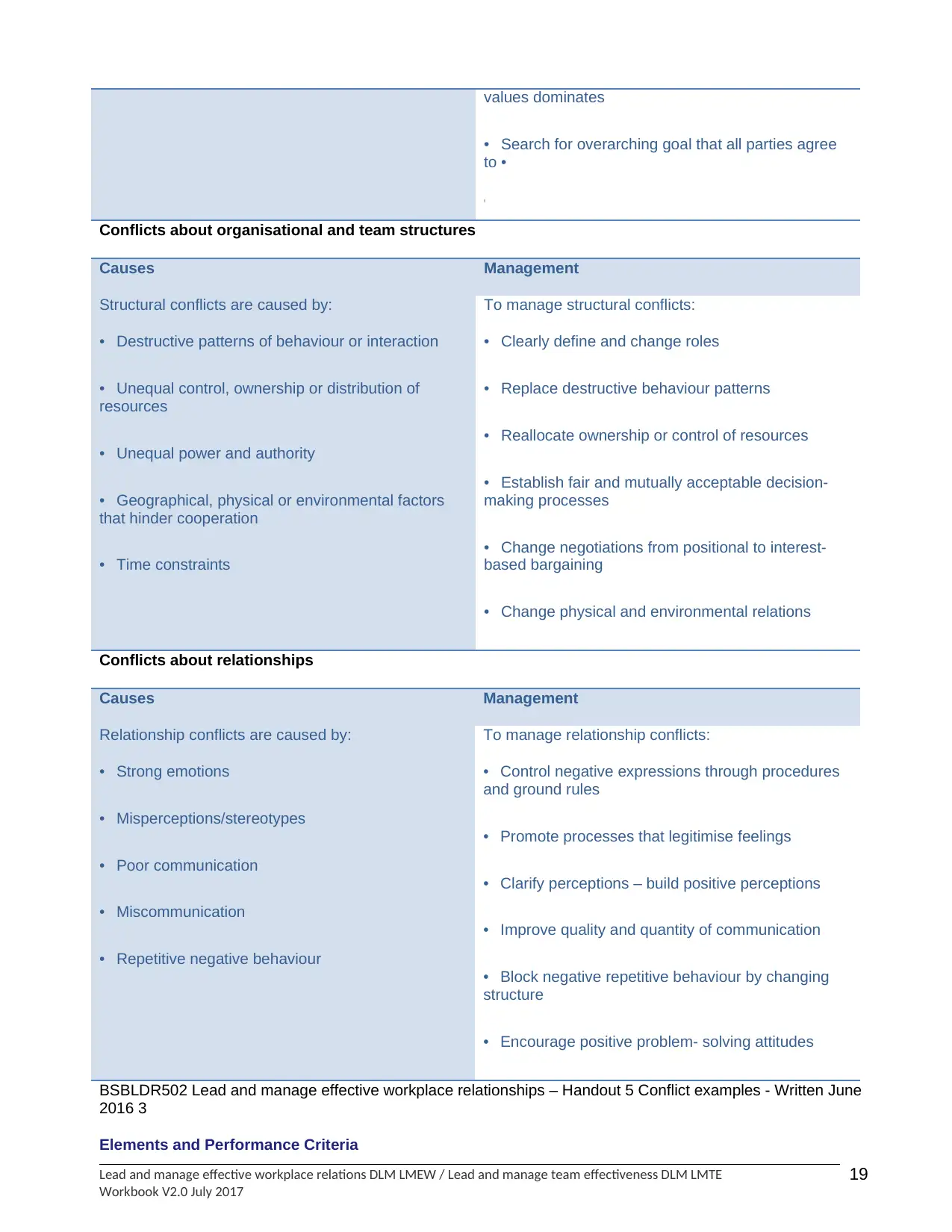
values dominates
• Search for overarching goal that all parties agree
to •
Conflicts about organisational and team structures
Causes Management
Structural conflicts are caused by:
• Destructive patterns of behaviour or interaction
• Unequal control, ownership or distribution of
resources
• Unequal power and authority
• Geographical, physical or environmental factors
that hinder cooperation
• Time constraints
To manage structural conflicts:
• Clearly define and change roles
• Replace destructive behaviour patterns
• Reallocate ownership or control of resources
• Establish fair and mutually acceptable decision-
making processes
• Change negotiations from positional to interest-
based bargaining
• Change physical and environmental relations
Conflicts about relationships
Causes Management
Relationship conflicts are caused by:
• Strong emotions
• Misperceptions/stereotypes
• Poor communication
• Miscommunication
• Repetitive negative behaviour
To manage relationship conflicts:
• Control negative expressions through procedures
and ground rules
• Promote processes that legitimise feelings
• Clarify perceptions – build positive perceptions
• Improve quality and quantity of communication
• Block negative repetitive behaviour by changing
structure
• Encourage positive problem- solving attitudes
BSBLDR502 Lead and manage effective workplace relationships – Handout 5 Conflict examples - Written June
2016 3
Elements and Performance Criteria
Lead and manage effective workplace relations DLM LMEW / Lead and manage team effectiveness DLM LMTE
Workbook V2.0 July 2017
19
• Search for overarching goal that all parties agree
to •
Conflicts about organisational and team structures
Causes Management
Structural conflicts are caused by:
• Destructive patterns of behaviour or interaction
• Unequal control, ownership or distribution of
resources
• Unequal power and authority
• Geographical, physical or environmental factors
that hinder cooperation
• Time constraints
To manage structural conflicts:
• Clearly define and change roles
• Replace destructive behaviour patterns
• Reallocate ownership or control of resources
• Establish fair and mutually acceptable decision-
making processes
• Change negotiations from positional to interest-
based bargaining
• Change physical and environmental relations
Conflicts about relationships
Causes Management
Relationship conflicts are caused by:
• Strong emotions
• Misperceptions/stereotypes
• Poor communication
• Miscommunication
• Repetitive negative behaviour
To manage relationship conflicts:
• Control negative expressions through procedures
and ground rules
• Promote processes that legitimise feelings
• Clarify perceptions – build positive perceptions
• Improve quality and quantity of communication
• Block negative repetitive behaviour by changing
structure
• Encourage positive problem- solving attitudes
BSBLDR502 Lead and manage effective workplace relationships – Handout 5 Conflict examples - Written June
2016 3
Elements and Performance Criteria
Lead and manage effective workplace relations DLM LMEW / Lead and manage team effectiveness DLM LMTE
Workbook V2.0 July 2017
19
Paraphrase This Document
Need a fresh take? Get an instant paraphrase of this document with our AI Paraphraser
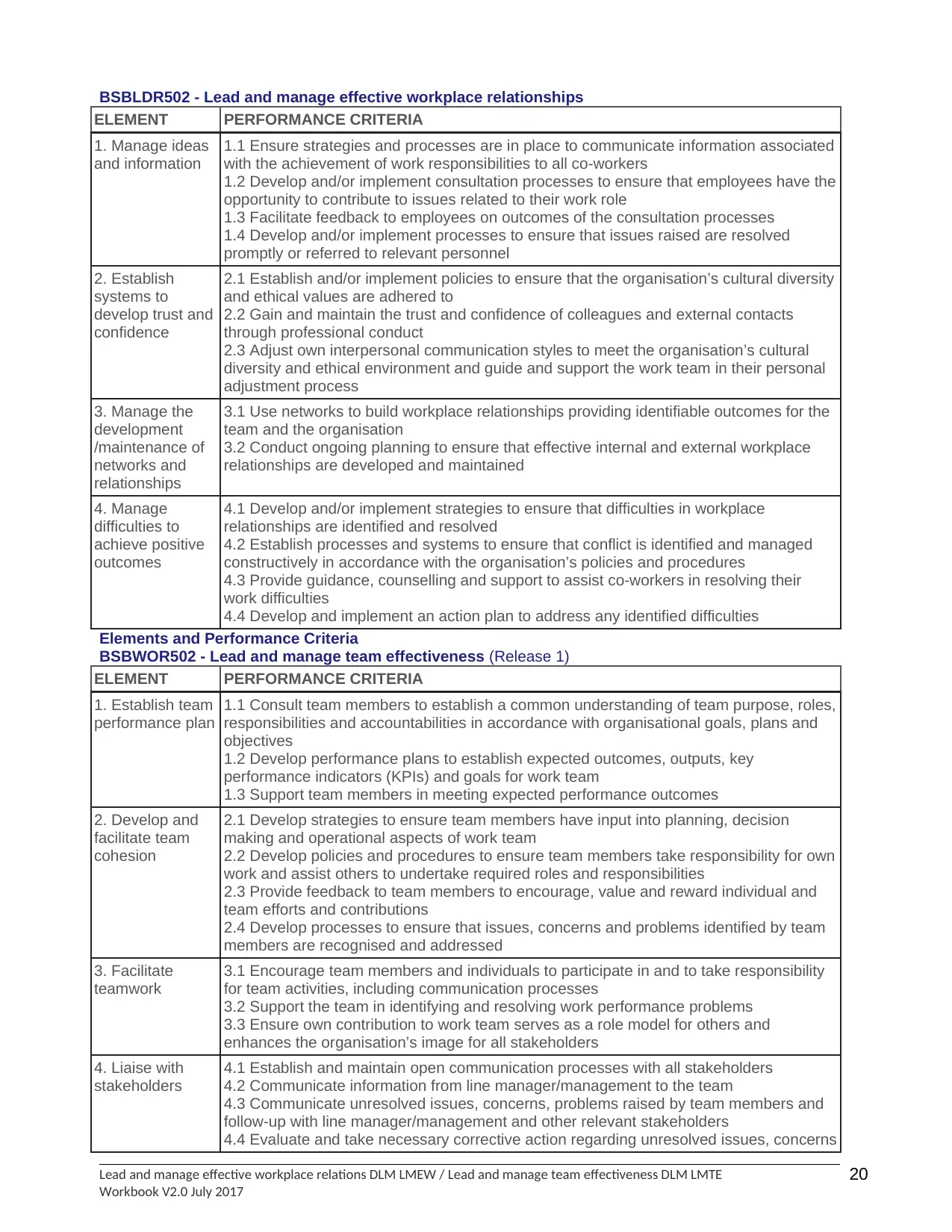
BSBLDR502 - Lead and manage effective workplace relationships
ELEMENT PERFORMANCE CRITERIA
1. Manage ideas
and information
1.1 Ensure strategies and processes are in place to communicate information associated
with the achievement of work responsibilities to all co-workers
1.2 Develop and/or implement consultation processes to ensure that employees have the
opportunity to contribute to issues related to their work role
1.3 Facilitate feedback to employees on outcomes of the consultation processes
1.4 Develop and/or implement processes to ensure that issues raised are resolved
promptly or referred to relevant personnel
2. Establish
systems to
develop trust and
confidence
2.1 Establish and/or implement policies to ensure that the organisation’s cultural diversity
and ethical values are adhered to
2.2 Gain and maintain the trust and confidence of colleagues and external contacts
through professional conduct
2.3 Adjust own interpersonal communication styles to meet the organisation’s cultural
diversity and ethical environment and guide and support the work team in their personal
adjustment process
3. Manage the
development
/maintenance of
networks and
relationships
3.1 Use networks to build workplace relationships providing identifiable outcomes for the
team and the organisation
3.2 Conduct ongoing planning to ensure that effective internal and external workplace
relationships are developed and maintained
4. Manage
difficulties to
achieve positive
outcomes
4.1 Develop and/or implement strategies to ensure that difficulties in workplace
relationships are identified and resolved
4.2 Establish processes and systems to ensure that conflict is identified and managed
constructively in accordance with the organisation’s policies and procedures
4.3 Provide guidance, counselling and support to assist co-workers in resolving their
work difficulties
4.4 Develop and implement an action plan to address any identified difficulties
Elements and Performance Criteria
BSBWOR502 - Lead and manage team effectiveness (Release 1)
ELEMENT PERFORMANCE CRITERIA
1. Establish team
performance plan
1.1 Consult team members to establish a common understanding of team purpose, roles,
responsibilities and accountabilities in accordance with organisational goals, plans and
objectives
1.2 Develop performance plans to establish expected outcomes, outputs, key
performance indicators (KPIs) and goals for work team
1.3 Support team members in meeting expected performance outcomes
2. Develop and
facilitate team
cohesion
2.1 Develop strategies to ensure team members have input into planning, decision
making and operational aspects of work team
2.2 Develop policies and procedures to ensure team members take responsibility for own
work and assist others to undertake required roles and responsibilities
2.3 Provide feedback to team members to encourage, value and reward individual and
team efforts and contributions
2.4 Develop processes to ensure that issues, concerns and problems identified by team
members are recognised and addressed
3. Facilitate
teamwork
3.1 Encourage team members and individuals to participate in and to take responsibility
for team activities, including communication processes
3.2 Support the team in identifying and resolving work performance problems
3.3 Ensure own contribution to work team serves as a role model for others and
enhances the organisation’s image for all stakeholders
4. Liaise with
stakeholders
4.1 Establish and maintain open communication processes with all stakeholders
4.2 Communicate information from line manager/management to the team
4.3 Communicate unresolved issues, concerns, problems raised by team members and
follow-up with line manager/management and other relevant stakeholders
4.4 Evaluate and take necessary corrective action regarding unresolved issues, concerns
Lead and manage effective workplace relations DLM LMEW / Lead and manage team effectiveness DLM LMTE
Workbook V2.0 July 2017
20
ELEMENT PERFORMANCE CRITERIA
1. Manage ideas
and information
1.1 Ensure strategies and processes are in place to communicate information associated
with the achievement of work responsibilities to all co-workers
1.2 Develop and/or implement consultation processes to ensure that employees have the
opportunity to contribute to issues related to their work role
1.3 Facilitate feedback to employees on outcomes of the consultation processes
1.4 Develop and/or implement processes to ensure that issues raised are resolved
promptly or referred to relevant personnel
2. Establish
systems to
develop trust and
confidence
2.1 Establish and/or implement policies to ensure that the organisation’s cultural diversity
and ethical values are adhered to
2.2 Gain and maintain the trust and confidence of colleagues and external contacts
through professional conduct
2.3 Adjust own interpersonal communication styles to meet the organisation’s cultural
diversity and ethical environment and guide and support the work team in their personal
adjustment process
3. Manage the
development
/maintenance of
networks and
relationships
3.1 Use networks to build workplace relationships providing identifiable outcomes for the
team and the organisation
3.2 Conduct ongoing planning to ensure that effective internal and external workplace
relationships are developed and maintained
4. Manage
difficulties to
achieve positive
outcomes
4.1 Develop and/or implement strategies to ensure that difficulties in workplace
relationships are identified and resolved
4.2 Establish processes and systems to ensure that conflict is identified and managed
constructively in accordance with the organisation’s policies and procedures
4.3 Provide guidance, counselling and support to assist co-workers in resolving their
work difficulties
4.4 Develop and implement an action plan to address any identified difficulties
Elements and Performance Criteria
BSBWOR502 - Lead and manage team effectiveness (Release 1)
ELEMENT PERFORMANCE CRITERIA
1. Establish team
performance plan
1.1 Consult team members to establish a common understanding of team purpose, roles,
responsibilities and accountabilities in accordance with organisational goals, plans and
objectives
1.2 Develop performance plans to establish expected outcomes, outputs, key
performance indicators (KPIs) and goals for work team
1.3 Support team members in meeting expected performance outcomes
2. Develop and
facilitate team
cohesion
2.1 Develop strategies to ensure team members have input into planning, decision
making and operational aspects of work team
2.2 Develop policies and procedures to ensure team members take responsibility for own
work and assist others to undertake required roles and responsibilities
2.3 Provide feedback to team members to encourage, value and reward individual and
team efforts and contributions
2.4 Develop processes to ensure that issues, concerns and problems identified by team
members are recognised and addressed
3. Facilitate
teamwork
3.1 Encourage team members and individuals to participate in and to take responsibility
for team activities, including communication processes
3.2 Support the team in identifying and resolving work performance problems
3.3 Ensure own contribution to work team serves as a role model for others and
enhances the organisation’s image for all stakeholders
4. Liaise with
stakeholders
4.1 Establish and maintain open communication processes with all stakeholders
4.2 Communicate information from line manager/management to the team
4.3 Communicate unresolved issues, concerns, problems raised by team members and
follow-up with line manager/management and other relevant stakeholders
4.4 Evaluate and take necessary corrective action regarding unresolved issues, concerns
Lead and manage effective workplace relations DLM LMEW / Lead and manage team effectiveness DLM LMTE
Workbook V2.0 July 2017
20
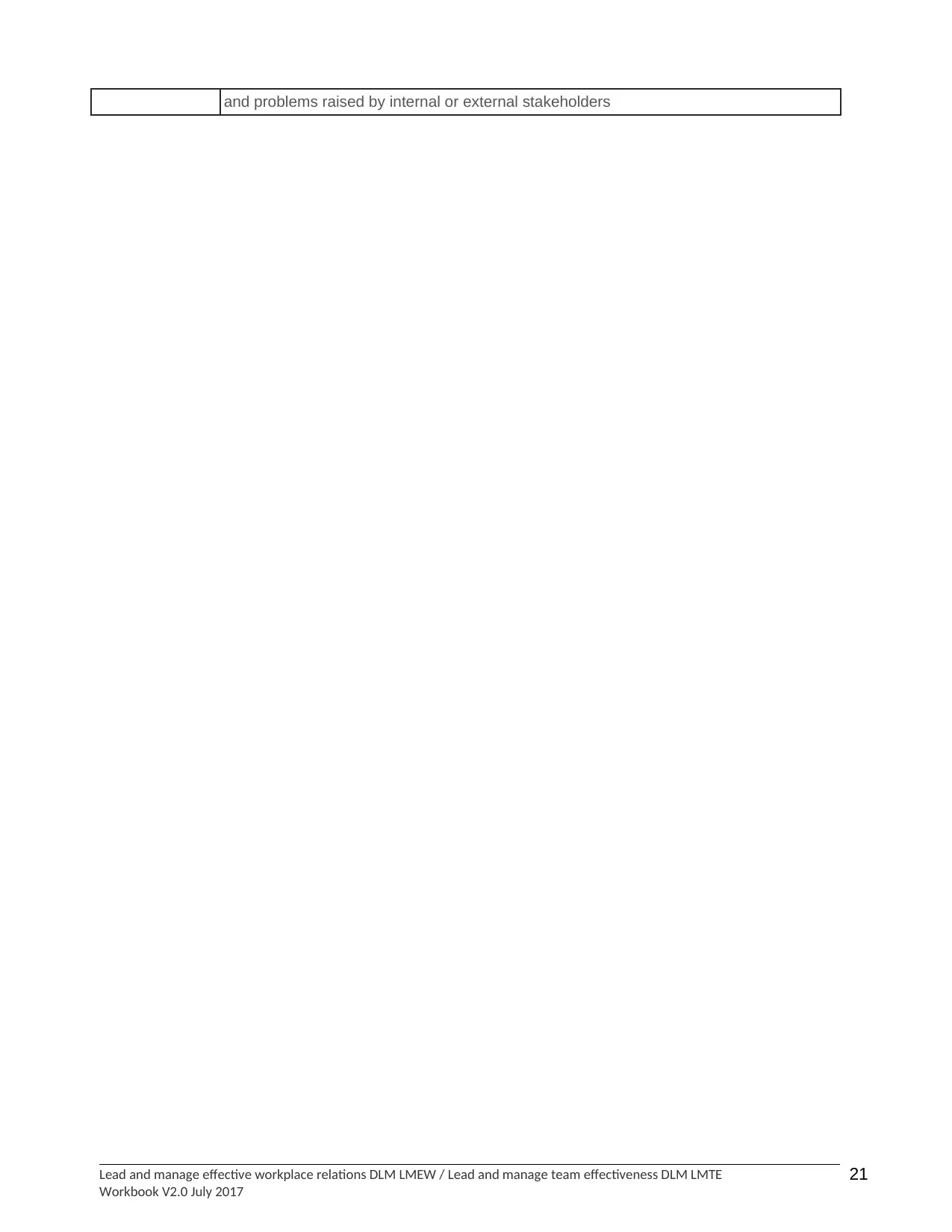
and problems raised by internal or external stakeholders
Lead and manage effective workplace relations DLM LMEW / Lead and manage team effectiveness DLM LMTE
Workbook V2.0 July 2017
21
Lead and manage effective workplace relations DLM LMEW / Lead and manage team effectiveness DLM LMTE
Workbook V2.0 July 2017
21
1 out of 21
Related Documents
Your All-in-One AI-Powered Toolkit for Academic Success.
+13062052269
info@desklib.com
Available 24*7 on WhatsApp / Email
![[object Object]](/_next/static/media/star-bottom.7253800d.svg)
Unlock your academic potential
© 2024 | Zucol Services PVT LTD | All rights reserved.





